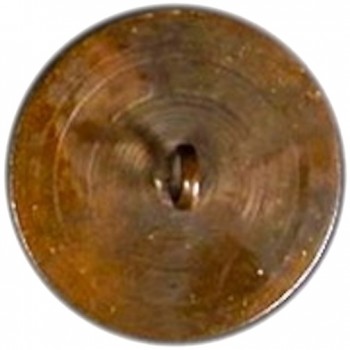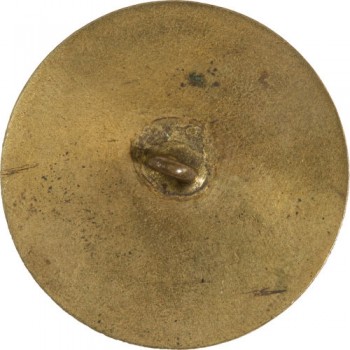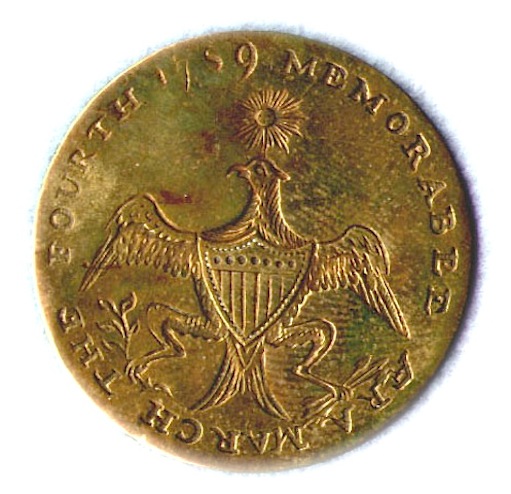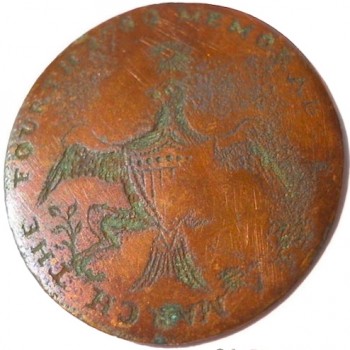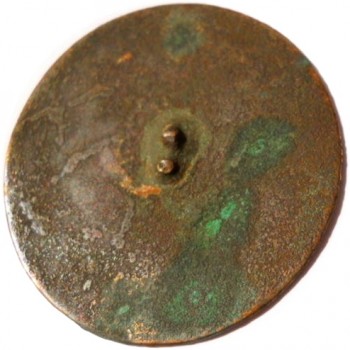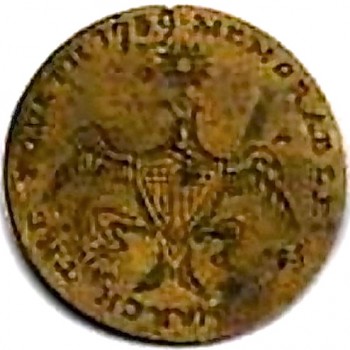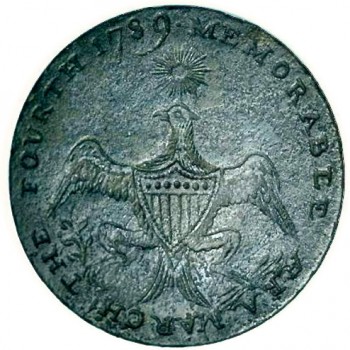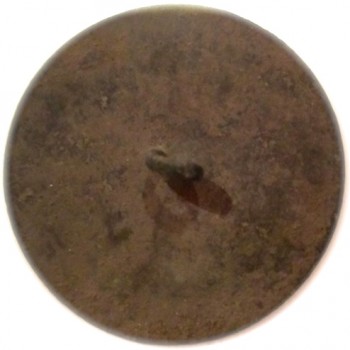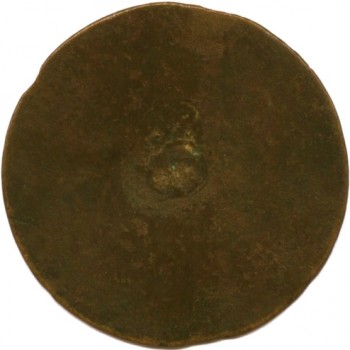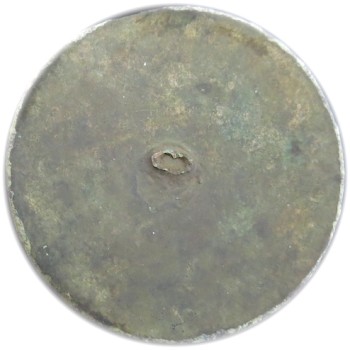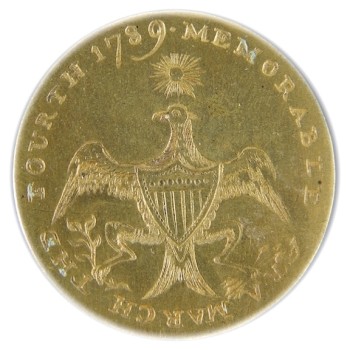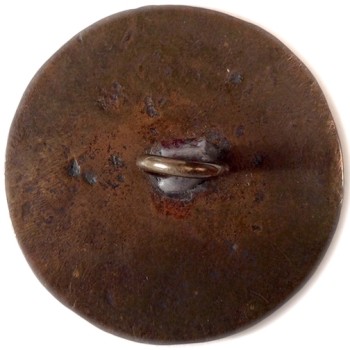“The Articles of Confederation only provided the states with a limited means of prosperity, a new Federal Union was needed for America to be on the World’s Stage.”
~ When The Mason’s Constitution sees Fruition ~
“I believe that George Washington Inaugural & New Nation Tribute buttons are not only America’s 1st, but most important Historical Artifact.
The American View
GWI 1’s design is a variation of the official Coat of Arms of the United States of America. The button depicts a proud Heraldic Bald Eagle with it’s wings outstretched. In the eagle’s left talon is a small Bundle of Three Arrows. This represent the three branches of U.S. government. The Executive branch for the President, the Legislative branch for Congress, and the Judicial to represent the U.S. Courts. Clutched in the eagle’s right talon is an Olive Branch which symbolizes peace. The eagle’s head faces (right) toward the olive branch to reflect the sentiment of the American people’s preference for peace. When all three symbols are taken together it symbolizes that the United States has a strong desire for peace, but will always be ready for war. Also, by the Eagle proudly splaying it’s wings in the sun it signifies that America has both the strength and readiness to move forward as a unified country into the New Era. Above the eagle’s head is the Sun with a large number of rays shinning brightly. In one variant, GWI 1-A, the Sun has a smiling face. This depiction of the Sun shinning brightly over the Eagle’s head is to symbolize a New Dawn or New Beginning for America as a new country. Blazoned over the Eagle’s chest is a Escutcheon (shield) with 7 horizontal stipples and 13 vertical stripes. The shield’s representation should be taken with the eagle together to represent that America will not need any other supporters and rely on it’s own virtue. In my opinion, the 7 horizontal stipples (dots) across the top of the shield represent the countries from which the the States have been peopled ( England, Scotland, Ireland, France, Germany, and Holland). The 13 vertical stripes in the lower portion of the shield represents the 13 states that have become unified as one. This shows support for the Commander and Chief who unites the whole country and represents Congress. The stripes are kept closely united on the shield to reflect that the President depends upon that tight union as well as the strength that results from that compact. The Letter and Number Date reflect the first time the new Congress convened under the newly ratified Constitution. Prior to this, the individual states were empowered by the Articles of Confederation to govern themselves. The Catchphrase, “Memorable Era” could have come directly from the July 4, 1788 Grand Federal Parade in Philadelphia. The keynote of this celebration was, “New Era.” Afterwards, “Memorable” and “New Era” was mentioned a great deal in prose and poetry.
GWI Button Connection to American Freemasons
Link: www.georgewashingtoninauguralbuttons.com/gwi-nnt-button-links-to-american-freemasons/
If you don’t mention something about the Men of Freemasonry with GWI Buttons, it would be like not mentioning the United States Mint when talking about coins. – Robert J. Silverstein
Scottish Royal Culture Symbols in GW Inaugural Buttons
The Eagle: is a Phoenix is Prince Edward Stuart’s Birth song Dec 31, 1720 Pope Clement XI. Later in America it symbolizes and then infuses the re-birth of the Jacobite Royal families back into positions of power. Robert Scot took the Zoroastrian alter of fire rebirth, Bonnie Prince’s Phoenix, Charles the Confessors Right of Sovereignty letter “E” and infused it into the fabric of America’s new societal construct known as the Grand Architects Design. BAM, THERE IS HISTORY BROTHER!
The Three Arrows: The Royal Company of Archer’s insignia. This goes back to Mary Queen of Scot who in yearly tournament was presented 3 arrows by their Lifeguard. Also, layered in allusion is it represents The King of Scotland, England, and Ireland.
The Seven Stipples in Shield: The 7 Earls of Scotland. God’s number 7. 7 levels of education.
The Five Petal Olive Branch: Represents the Bonnie Prince Charlie’s 5 Petal White Rose.
Meridian Sun: Scottish Masonic Celestial Navigation & Geometry.
Shinning on the New Republic: Jacobites came to America in 1715 to form a New Republic.
The New Republic: The Separation of Church & State, the Equality of Men, and the Freedom of Speech. Representative Government and Majority Rule. All Masonic Constitutional Codes our Founding Father’s Cherished and Valued from their Social Masonic Lodges and Placed into the Framework of the U.S. Constitution.
Certain Variations Depict 33 Feathers in the Eagle’s Wings: Scottish Masonic Degrees of Knowledge.
Collector’s notes: So far, I have collected, and identified American engraved Sub-Variants of all most every GWI pattern. Even though more then one sub-variant can exist for a particular pattern, I have found evidence that certain ones contain Scottish-Rite, Roman, and Religious symbols. There is a historical puzzle which must be framed properly for the acceptance for historical introduction. If correct this will tell the (hidden)seldom told story not seen by all. I must take the time out to properly diagram and reference all the “Allusions” on the buttons for later collectors. -RJ. Silverstein
GWI 1-A, B & C MARCH THE FOURTH 1789 * MEMORABLE ERA:
Steel Die Engraving: Robert Scot and his Philadelphia Crew: , J. Vallance, Francis Shallus, J. Thackera, J. Trenchard, and Samuel Allerdise.
Metal Planchet Allow: Brass, Bronze (Rare), Copper.
Metal Finish: Gilt or Silvered.
Construction: 1-Piece With A Soldered on Loop Shank for Attachment.
Size Range: 33 to 34mm.
Variety Types: The Pointed 9 Tail, The 9’s J-Knob Tail, Lathe Turned, Anniversary Editions & Replicas.
Estimated Number Known: 65-85.
Rarity Ratings: All Varieties: R-1 / GWI 1-A & GWI 1-B: R-3 / GWI 1-C: R-4 / Anniversary & Replicas: R-1
Robert, you are correct, There are 7 patterns known to the dated eagle button. Three are reproductions R, AR1,RLV, in Albert’s book page 387. The two patterns you list on your site: WI 1-A The Pointed 9 Tail, and WI 1-B The Knob tail. The lathe turned backs is the third die variant- you still have not pictured any of these on your site, and the fourth is being kept out of the lime light by the owner. This makes a total of seven. -Dale
The “Pointed 9 Tail” shows the “9” in the numeral date “1789” reaching under the “8” with a shallow semi-curve on the 9’s tail. This ends in a blunt or sharp point.
The “Knob Tail” shows the tail-end of the “9” in a J-Hook, with it’s tail in a slight Ball or deeper “Round Knob.” Additionally, the Arrow’s Nock Feathers just fall short of the “M” in March.
Since a new steel die was fashioned and the original design was altered for the “Arrows” and “J-Knob Knob Tail, ” I decided to list GWI 1-B as a New Sub-Variant of GWI 1. This will allow serious GWI variety collectors to make the distinction between all three types of GWI 1 buttons in their collection.
It is my professional opinion, GWI 1-C (American Lathe Turn Reverse) was made during Washington’s Administration (1789 to 1797). Studying the engraving cuts for authenticity of period, i noticed several engraving differences. I concluded that GWI 1-C was made by a very skilled Engraving Apprentice, and not a Master Engraver. Commissioned work taken on by Masters engravers would have demonstrated proper spacing, sizing, and cutting. This button could have been easily made outside, or on-the-side of any commissioned contract. *Collector’s should note, this variant has several small distinguishing features which is inclusive to Scottish-Rite and Ancient Roman Message. This button should be seen as a symbol in Plain Sight. So, make no mistake about the value of this button. It was made by an American Engraver for a specific purpose during the inaugural festivities during Washington’s Administration. I own 6, and this is my favorite – American Made, Real Meaning!
Most of the art like the Eagle was designed by Robert Scot who was a Scottish-Rite Master Artisan. Meaning, he was a “Hidden Master” out of the main stream public’s eyes. He used his social stature and his respected artistry gifts to control the guild. This was reinforced by his Scottish social stature and prominent position held inside of Masonic Social Lodge. He also would be the only “proper” person ( Social Etiquette) that could accept a guild commission on artistry project. Guild members were not allowed to accept work, it had to go through proper channels which was Master Robert Scot. He would in-turn delegate the work to his other Fellow-Craft guild members and apprentices.

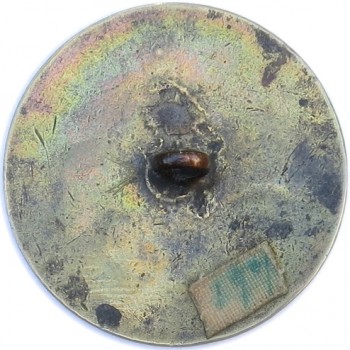
GWI 1-B MARCH THE FOURTH 1789 * MEMORABLE ERA “The Jesse Lewis”
Color: A Colorful Iridescent Brass Yellow with Flairs of Blue, Purple, Orange, Yellow, & Green.
Metal: Flat, 1-Piece, Impressed Design, Gilt Brass.
Size: 33.95mm.
Rarity: R-3
Variety Type: The 9’s J-Knob Tail.
Present Condition: A Non Excavated Specimen, Excellent Planchet Condition, An Exceptional Impression Remains.
Obverse Button Analysis: This is an exceptional specimen that was originally purchased sometime in 1789, by Jesse Lewis for the country’s year long celebration. He was a Revolutionary War soldier and enlisted on May 24th, 1775. The button has a very strong design strike impression, and a nice iridescent Multi-Color Patina to the brass planchet. The Eagle has a strong strike impression for the head, body and feathers. The button also displays a nice image of all the inner feather details in the neck & wings. The Federal Shield is strongly displayed with all the outer perimeter stipples showing clearly. All the shield’s inner 7 stipples and 13 vertical stripes are boldly displayed with only marginal wear in two of the stripes ends. The Olive Branch still has a nice deep impression, with a clear image of all 5 petals and their inner texture lines. The Meridian Sun and it’s Rays show a clear image without distraction. The 1789, Number Date has an outstanding impression with all clean lines. As with the number date, the Letter Date and Catchphrase shows good clean letter lines that are easy to read. This is one of the nicest specimens (Top 3) known to exist in all of the GWI 1-A variety. With the Added Provenance linking it to an American Revolutionary War Solider it makes this a true Jewel among GWI buttons.
Reverse Button Analysis: This is flat a one-piece button with a soldered on loop shank. The shank is original, straight, and intact.
Library Records Has Limited Information GWI B-1:
History: Yes Recorded Sales Price: Yes
Current Button Owner and Location: ~ New York ~
The Isabela Collection.~

Purchased by Robert J. Silverstein in 2015.
Gifted to William Cadman JR. in the mid to late 1950’s ( Mabel Frost’s Grandson ).
Previous Owner Mabel Frost-Fischer November 1956.
Purchased by Mabel Frost-Fisher Agent Marcia France who obtained this Privately from the Adam’s Family in November 1956.
This Family Heirloom was passed down to Marguerite A. Adams from her Mother’s family on May 25th, 1875
.
* Originally Purchased by Revolutionary War Soldier Jesse Lewis (April 6, 1752 to February 25, 1842) somewhere in 1789. Jessie Lewis enlisted in the Revolutionary Army on May 24th, 1775.
**Provenance Links: Revolutionary War Soldier Jesse Lewis was Marguerite Adams Mother’s uncle (Connection).
This was registered with the W.I.B.S on October 1st 1944 as the “Jesse Lewis” Specimen.
Example # 87 by David F. Johnson. This is one of 2 specimens owned by the family. The other registered number by David Johnson is GWI 11-A, and is noted in that section.
**Purchased by Marcia France on November 1956 acting as an agent for Mabel Frost-Fischer.


GWI 1-A MARCH THE FOURTH 1789 * MEMORABLE ERA
Color: An Olive Brass Yellow with Brown Flecks.
Metal: Flat, 1-Piece, Impressed Design, Brass.
Size: 34mm.
Rarity: R-3
Variety Type: The Pointed 9 Tail.
Present Condition: A Non Excavated Specimen. Excellent Planchet Condition, An Exceptional Impression Remains.
Obverse Button Analysis: I believe this is one of the best known examples for The Pointed 9 Tail Variety. I would judge this as near Mint or Museum quality condition. This button’s design has the appearance as if it was etched by hand, instead of impressed by a steel die. The brass planchet is solid and flat, and shows no signs of metal fatigue or deterioration. The surface is smooth to the touch, and is free of scratches, blemishes, pits or abrasions. The Eagle still retains a nice deep strike for the head, body and feathers. The fathers displays a nice clear image of all the inner line details. The Liberty Shield appears flawless, and lends completely to the original line and stipple design. The inner horizontal stipples and vertical stripes are crystal clear with a nice deep impressions. The Olive Branch retains a nice clean deep stamp, with a clear image of all the individual petals. The Bundle of Arrows is magnificently impressed for this variety, and shows perfect detail to the three Arrow Tips, Shafts, and Nock Feathers. (This Bundle of Arrows could possibly be one of the finest example known). The 1789, Letter Date, and Catchphrase all have a nice deep stamp with clean letter lines that are easy to read. Between the light yellow brass color and the excellent impressions, this button gives a spectacular presentation.
Reverse Button Analysis: This is flat a one-piece button with a soldered on loop shank. The shank is original, straight and intact. The surface is smooth, and free of any scratches or abrasions. The color is even and consistent throughout.
Library Records Has Limited Information GWI A-1:
History: Yes Recorded Sales Price: Yes
Current Button Owner and Location: No
GWI 1-B MARCH THE FOURTH 1789 * MEMORABLE ERA
Color: A Mustard Brass.
Metal: Flat, 1-Piece, Impressed Design, Bronze?
Size: 34.20mm.
Rarity: R-5
Variety Type: The 9’s J-Knob Tail.
Present Condition: A Non Dug Specimen, Exceptional Planchet Condition, An exceptional Impression Remains.
Obverse Button Analysis: One of the nicest remaining specimens. The Eagle retains a good deep strike, and displays a crisp image of the head, body, and feathers. The Federal Shield is pristine with all the outer perimeter stipples showing clearly. All the shield’s inner 7 stipples and 13 vertical stripes are boldly displayed without any kind of wear. The Olive Branch still has a nice deep impression, with a clear image of all 5 petals and their inner texture lines. The Bundle of 3 Arrows unfortunately only has a light footprint impression, and the middle shaft is almost absent. The detail for the arrow tips, shafts, and nock feathers lack inner detail because of a weak strike, but the design still holds a good image. The Meridian Sun shows a nice deep strike for all the rays. There is a good crisp image of the Sun and all of it’s Rays. The 1789, Letter Date, and Catchphrase all have nice straight letter lines that are easy to read. Only the “E” in ERA only has a weak strike, but readable.
Reverse Button Analysis: This is a flat one-piece button with a soldered on loop shank. The shank is original, straight and intact. The surface is smooth, and free of any scratches or abrasions.
Library Records Has Limited Information GWI 1-B-2 :
History: Yes Recorded Sales Price: Yes
Current Button Owner and Location: No
The J. Armineger Collection.
GWI 1-C MARCH THE FOURTH 1789 * MEMORABLE ERA “The American Apprentice.”
American Lathe Turn Reverse
Color: A Colorful Iridescent Gilt Brass Yellow with Flairs of Gold, Orange, Yellow, & Green.
Metal: Flat, 1-Piece, Impressed Design, Gilt Brass.
Size: 35.01mm.
Rarity: R-6.
Variety Type: Lathe Turn Reverse / No Date “Dot” / Letter Sizes & Cuts / Meridian Sun Leg Impressions.
Present Condition: A Non Excavated Specimen, Excellent Planchet Condition, An Exceptional Impression Remains.
Obverse Button Analysis: This button was made by an American Apprentice to the Graving Guild. Most likely sold and produced outside of any guild commissioned work.
Reverse Button Analysis: This is flat a one-piece Lathe Turn button that has a soldered on loop shank. The shank is original, straight, and intact.
Library Records Has Limited Information GWI B-C.1:
History: Yes Recorded Sales Price: Yes
Current Button Owner and Location: ~ New York ~
The Isabela Collection.~
GWI 1-C
American Lathe Turned Reverse
This GWI 1-C Specimen has a “Lathe Turn Back,” and should be classified as a new Sub-Variant for GWI 1. Even though there is several distinctions between GWI A, B, C. there is enough differences to justify it’s own Sub Variant letter-“C” under the commonality of GWI 1. There is no doubt the sub-variant was fabricated during Washington’s 1st Administration. The distinction between this variant and other George Washington inaugural sub-variants in all classes, is that this lathe turn reverse button is believed to be made by an Apprentice. Meaning, not made in England, and outside of normal guild contracts.
Wheels spinning, I believe the gentlemen of the Post Colonial Era engraving guild were congratulating each other and patting themselves on the back for being able to produce a “high quality engraving of a GWI button that was equal to the work of the Master Button Engravers in England. Well, this button was not made by those artisan engravers..lol. They made other GWI’s with Federal insignia. Probably, more parallel with their entrance work with U.S. insignia followed close by seals & coins. — My Collector’s thoughts.
I have to conquer with button Grandmaster Dale, and say this was done by a skilled apprentice of the Era. There are a few size and cut errors a Master Engraver would not allow in this final die product. Out of the 5 known surviving specimens, three are copper and two are brass. What I like about this George Washington Inaugural Button GWI 1-C, is that it was made here in America, and not England as the other die hub’s GWI 1-A & B. Since, it was made in both Gilt brass and copper, one can reasonably assume it was produced and sold in some small quantity. For collectors of 18th century buttons, one can appreciate the time honored style of a lathe turn reverse on a Big Size Dandy button. GWI 1-C demonstrates that American Engraving Artist in the colonies were able to produce high quality cut pieces that were equal to English counterparts. Since, I am an advent collector of GWI buttons, I personally place a higher value on GWI 1-C over GWI A & B. A collector of inaugural buttons should seek the few known specimens that were engraved, manufactured, and sold in America. With this rare sub-variant, there could be a strong chance it was custom made for a Masonic lodge or sold by the engraver himself! A reflection of insignia within the Eagle’s Leg will be crossmatched to both Scottish-Rite and Roman symbolism. I will be presenting 2 more buttons with the “3 Dots” and Squiggly Line.
Hello Robert,
Yes your button is like the three I have in my collection it is a nice button you bought. I don’t know if these are American Lodge made buttons most likely they are but I do not think they were made in England. Likely American made the French & English were more advanced although I see GREAT FRENCH & ENGLISH made 18th century buttons lathe turned. The engraver made a fatal or rookie mistake when he engraved the die for these George Washington Buttons and his problem was corrected only by making THICK plugs or disc of copper and brass then he turned the buttons down on a lathe after they were die stamped. Otherwise his die would be worthless trying to apply this dated Washington pattern to the standard blanks available to all button manufacturers at the time.
Regards,
Dale.
There are some differentiating characteristics in the design pattern which should be noted. First, there is no dot after 1798 date. Second, collector’s will note that some letters are cut differently, but 98% of the letters are the same. The “1” in the date depicts a shorten length. Also note, there is another sub variant without the “dot” after the date, but not a blunt “1”. The “S” pattern used instead of a completed “8” in the date is known in other mass produced dated varieties. This also gives evidence to period. This new Sub-Variant depicts a slightly different Sun Ray pattern. Dale noted if you put a different sun, the heraldic estoile over this pattern, you have the same sun as the known smiley face dated mass produced varieties, count these small rays on these examples and remove the six or eight pointed estoile and you have this sun pattern. (Confusing but accurate) This variant’s Eagle has slightly different wing and tail feathers. It is my Firm believe that this Sub-variant GWI 1-C was made right here in America!
not finished.
GWI 1-A MARCH THE FOURTH 1789 * MEMORABLE ERA
Color: An Iridescent Brass Yellow with Flairs of Green & Red.
Metal: Flat, 1-Piece, Impressed Design, Gilt Brass.
Size: 34mm.
Rarity: R-3
Variety Type: The Pointed 9 Tail.
Present Condition: A Non Excavated Specimen, Excellent Planchet Condition, An Exceptional Impression Remains.
Obverse Button Analysis: This is an exceptional specimen with good strong impressions. As with most un-dug brass buttons this one has beautiful iridescent color qualities. The planchet is solid, and shows no signs of metal fatigue, decay or deterioration. The surface shows no scratches or harsh abrasions. The Eagle has a nice deep strike for the head, body and feathers. All the inner details lines of the feathers are shown clearly. The Liberty Shield has a strong strike impression and shows all of the perimeter’s stipples clearly. The inner horizontal stipples and the vertical stripes that are within the shield stand out boldly. The Olive Branch is also nicely struck, and displays a clear image of all 5 of the individual Petals. The Bundle of Arrows has outstanding clarity, and shows a crystal clear outline of the tips, shafts, and nock feathers. The Meridian Sun, and it’s all it’s Rays show good strong strike lines. The 1789, Date does lack a deep impression, but this could be the result of a shallow die cut. As with the Letter Date and Catchphrase all have good clean letter lines that are easy to read. This is an outstanding example with many superior attributes, and would be welcomed in my personal GW Collection anytime!
Reverse Button Analysis: This is flat a one-piece button with a soldered on loop shank. It was reported that the original shank was professionally restored, and the surface was noted to also have some small minor abrasions, but no heavy scratches.
Library Records Has Limited Information GWI 1-A-2:
History: Yes Recorded Sales Price: Yes
Current Button Owner and Location: No
Purchased from W.F. Sunday in 1956.~
Harold Cobb/Descendants 1956 to 2001
GWI 1-B MARCH THE FOURTH 1789 * MEMORABLE ERA
Color: A Nice Original Brass Yellow.
Metal: Flat, 1-Piece, Impressed Design, Brass.
Size: 34mm.
Rarity: R-3
Variety Type: The Pointed 9 Tail.
Present Condition: A Non Excavated Specimen. Excellent Planchet Condition, A Strong Impression Remains.
Obverse Button Analysis: This is a nicely aged button with a true yellow brass color. The planchet is solid and flat, and shows no signs of metal fatigue or deterioration. The surface is smooth, and only shows a few small scratches in the field, but has nicely blended in with the background color. The Eagle shows a strong outline from the die strike, and gives a crystal clear image of the inner head, body and feathers. Only the lower portions of the left leg & talon show a shallow strike impression. The Liberty Shield has a nice deep stamp, and gives a clear outline of all the perimeter dots. The inner horizontal dots and vertical stripes show in nice clear detail. Unfortunately, the Laurel Stem lack a deep strike, and only shows a shallow image of all the petals. The Bundle of Arrows also lacks a deep strike, but still demonstrates a clear depiction of all the arrow tips, shafts, and nock feathers. The Meridian Sun has a strong bold strike, and shows of all the individual Rays clearly. The 1789, and Letter Date all have nice deep letter impression that are easy to read. The Catchphrase shows a nice impression for most of the word MEMORABLE, except for the “E”, and also the word “ERA,” they lack a strong deep die strike. Overall this is an excellent example with great color. The inner feather detail alone makes this a true gem.
Reverse Button Analysis: This is flat a one-piece button with a soldered on loop shank. The shank is original, straight and intact. The surface is smooth, and free of any harsh scratches or abrasions. The color is even and consistent throughout.
Library Records Has Limited Information GWI 1-B-3:
History: Yes Recorded Sales Price: Yes
Current Button Owner and Location: No


GWI 1-B MARCH THE FOURTH 1789 * MEMORABLE ERA
Color: A Blackened Metal Patina.~
Metal: Flat, 1-Piece, Impressed Design, Bronze. (Only Bronze Specimen Known)
Size: 34.10mm.
Rarity: R-5
Variety Type: The 9’s J-Knob Tail.
Present Condition: A Non Excavated Specimen. Good Planchet Condition, A Strong Impression Remains.
Obverse Button Analysis: This is the only button known with a natural Black Patina in the metal. I am a bit perplexed about the alloy’s colour given it was sold by H.A. as Bronze. The planchet of the button is solid and flat, and shows no signs of metal fatigue or decay. The surface is smooth to the touch without any waviness or shallow depressions. The Eagle still retains a nice deep strike, and has a clear image of all the inner details of the head, body, and feathers. The Liberty Shield also retains a strong strike, and depicts all the outer perimeter dots clearly. All the shield’s inner dots and vertical stripes are clear and boldly displayed. The Laurel Stem still retains a nice deep impression, with a clear image of all the petals and their inner texture lines. The Bundle of Arrows unfortunately only has a light footprint impression, but still shows the clear detail for the arrow tips, shafts, and nock feathers. The Meridian Sun is still clearly shown with a strong deep strike. There is a good crisp image of the sun and all of it’s rays. The 1789 and Letter Date have nice straight letter lines that are easy to read. The Catchphrase still has a good readable image for MEMORABLE, but unfortunately the word ERA only has a vague reminisent outline of the original letters. This button is definitely a collectors must because of the metal colour and also the benefit for retaining a lot of it’s original design features.
Reverse Button Analysis: This is a flat one-piece button with a soldered on loop shank. The shank is original, straight and intact. The surface is smooth, and free of any scratches or abrasions.
Library Records Has Limited Information GWI 1-B-4:
History: Yes Recorded Sales Price: Yes
Current Button Owner and Location: ~ New York ~
The Isabela Collection.~


GWI 1-A MARCH THE FOURTH 1789 * MEMORABLE ERA
Color: A Tri-Color Green with Charcoal Impressions.
Metal: Flat, 1-Piece, Impressed Design, Brass.
Size: 34mm.
Rarity: R-3
Variety Type: The Pointed 9 Tail.
Present Condition: An Excavated Example, Strong Planchet Condition, A Strong Impression Remains.
Obverse Button Analysis: This inaugural button retains a strong strike impression with a clear image of the design. The brass planchet is solid and flat, but does show some signs of corrosion and micro porosity. The button is a bit coarse to the touch which is most likely the result of ground action. On a good note, the button shows no scratches, blemishes or abrasions to the surface. The Eagle has a nice deep strike, with a clear outline image of the head, body and feathers. The inner details of the head and feathers is also amazingly clear for a dug specimen. The Liberty Shield retains a good strong outline with a clear image of the perimeter dots. Unfortunately the stipples on the left hand side of the shield are muted into one another. The inner 7 horizontal dots for the upper portion of the shield has a nice deep strike impression, and still have a clear image. The vertical stripes in the shield’s lower portion are easily seen. The Olive Branch has a nice deep stamp, and clearly shows the stem and all the petals. The Bundle of Arrows retains a nice impression and has a good image for the arrow tips, shafts, and nock feathers. The Meridian Sun has a nice strike, and shows all it’s individual Rays clearly. The 1789, and Letter Date, and the Catchphrase still shows a nice impression with easily readable letters. Only the word, “ERA” is a bit weak.
Reverse Button Analysis: This is flat a one-piece button with a soldered on loop shank. The shank is original, and intact, but slightly bent.
Library Records Has Limited Information GWI 1-A-3:
History: Yes Recorded Sales Price: Digger Owner
Current Button Owner and Location: ~ South Carolina ~
Dug near Wilmington, North Carolina in 2008.
The Keith Nixon Collection.~
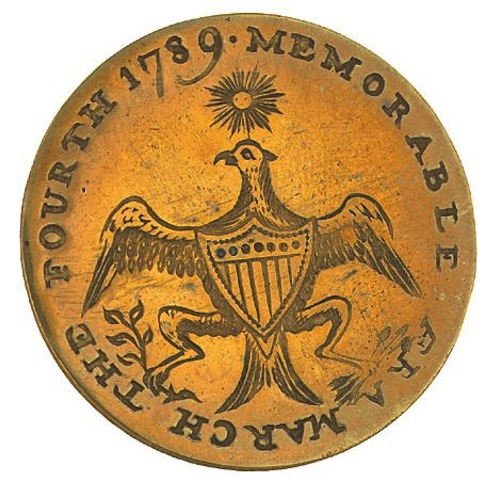
GWI 1-B MARCH THE FOURTH 1789 * MEMORABLE ERA
Color: A Deep Golden Brass Orange Hue Mix.
Metal: Flat, 1-Piece, Impressed Design, Gilt Brass.
Size: 34mm.
Rarity: R-3
Variety Type: The 9’s J-Knob Tail.
Present Condition: A Non Excavated Specimen, Excellent Planchet Condition, An Exceptional Impression Remains.
Obverse Button Analysis: This is a wonderfully preserved specimen that still has clarity to all of its original die impressions. The planchet is solid, with no metal deterioration or decay. The surface is smooth and flat, but unfortunately shows some very light abrasions and scratches which travels through the center going from outside the wings. On a positive note, time has been able to blend these blemishes in with the natural color tone of the metal. The Eagle still retains a nice strong strike with a clear depiction of the head, body, and feathers inner detail. The Liberty Shield also retains a nice deep strike with a clear image to the shield’s doted outline. The inner horizontal dots and vertical stripes are crystal clear without any muteness. The Laurel Stem also has a nice impression with good detail to all it’s petals. The Bundle of Arrows appears to be lightly struck, but still shows good detail for the arrow shafts, tips, and nock feathers. Both the shafts and left talon of the eagle unfortunately seem to be the weak impression spot. The Meridian Sun still retains a nice strong stamp, and it’s rays are individually defined with clarity. The 1789 and Letter Date has good straight letter lines and is easy to read. Only the word “ERA” in the catchphrase has a light foot print from the die stamp. Possibly the die didn’t use enough pressure when struck in that area for all three designs to be affected. I believe this to be an excellent specimen, and would be a crown jewel in anyone’s GW Collection.
Reverse Button Analysis: This is a flat one-piece button with a soldered on loop shank. The shank is original, straight and intact. There are no harsh scratches or abrasions to the surface.
Library Records Has Limited Information GWI 1 B-5:
History: Yes Recorded Sales Price: Yes
Current Button Owner and Location: No
GWI 1-A MARCH THE FOURTH 1789 * MEMORABLE ERA
Color: A Dark Chestnut Brown with Lighter Brown Highlights.
Metal: Flat, 1-Piece, Impressed Design, Copper.
Size: 34mm.
Rarity: R-3
Variety Type: The Pointed 9 Tail.
Present Condition: An Excavated Example, Strong Planchet Condition, A Strong+ Impression Remains.
Obverse Button Analysis: This specimen has a strong strike impression, and retains the original strike pattern extremely well. The copper planchet is solid and flat, and has a nice smooth surface. There appears to be very little signs of corrosion or decay to the metal surface. The Eagle retains a strong strike impression with a clear outline of the head, body and inner feathers. The Liberty Shield has a very strong strike outline, and shows of all the outside perimeter dots clearly without any sort of dot integration/mutation. The shields inner horizontal dots, and all the vertical stripes also have a crystal clear image. The Laurel Stem unfortunately has a weak strike, but still retains a clear depiction of the stem and petals. The Bundle of Arrows has a nice strike impression with a clear image of the arrow tips, shafts, and nock feathers. The Meridian Sun depicts a strong strike, and shows all it’s individual Rays clearly. The 1789, and Letter Date is unfortunately worn flat into the surface. There appears to be some sort of ground corrosion that is covering up most of the letters. The Catchphrase is stronger, and gives a strong letter image for MEMORABLE ERA. I like the patina’s color, and the image of the eagle. I don’t like the decay of the letters for the date or the 1789 numbers. All being said, this is a nice button and makes a great commemorative for collectors.
Reverse Button Analysis: This is flat a one-piece button with a soldered on loop shank. The shank is original, and intact, but bent over.
Library Records Has Limited Information GWI 1-A-4:
History: Yes Recorded Sales Price: Digger Owner
Current Button Owner and Location: ~ Maryland ~
Dug near an Old Stone Home in Emmitsburg, Maryland in 1981
The Valerie Avedon-Gariner Collection

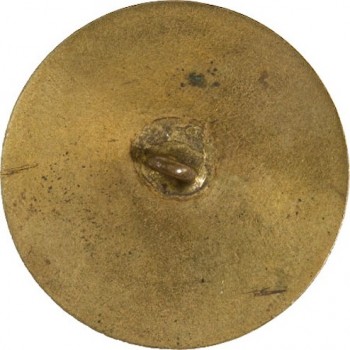
GWI 1-B MARCH THE FOURTH 1789 * MEMORABLE ERA
Color: A Nice Deep Golden Brass.
Metal: Flat, 1-Piece, Impressed Design, Brass.
Size: 34mm.
Rarity: R-5
Variety Type: The 9’s J-Knob Tail.
Present Condition: A Non Excavated Specimen, Strong Planchet Condition, A Strong Impression Remains.
Obverse Button Analysis: This is a rare 9 Knob Tail variation. The brass planchet is solid, and shows no waviness, metal fatigue, decay, or deterioration. The surface is smooth and flat with no bends or shallow depressions in the surface. The Eagle still shows a strong strike outline for the head, wings and inner feathers. Unfortunately, the neck feather and the lower portions of the legs including both talons appear to be either worn into the surface from wear; or possibly faulted in a deep die strike upon fabrication. The eagle’s left talon where it clutches the arrow’s shafts is unfortunately no longer visible. The outline of the Liberty Shield’s dots is still clearly shown. A few dots on the left hand side appear worn into the surface. The shields inner horizontal dots depict a weak image of the original stamp, and the vertical lines are completely worn smooth into the surface. The Laurel Stem still has a good outline along with their petals, but unfortunately has deep scratches covering over. The Bundle of Arrows only depicts a clear outline for the tips, and nock feathers. The shafts are worn smooth, or inadequately stamped into the surface. The Meridian Sun shows a nice deep strike with good clear image of the ray’s lines. The 1789 and Letter Date still retain a strong impression, and is still easily readable. Only the word “ERA,” in the catchphrase is worn smooth into the surface. Only the “E” remains intact for reading.
Reverse Button Analysis: This is a flat one-piece button with a soldered on loop shank. The shank is original, straight and intact. The surface is smooth with no harsh scratches or abrasions.
Library Records Has Limited Information GWI 1-B-6:
History: Yes Recorded Sales Price: Yes
Current Button Owner and Location: ~ California ~
Previously Owned by Dana Linet ~ Early American Auctions.

GWI 1-A MARCH THE FOURTH 1789 * MEMORABLE ERA
Color: A Rich Light Coppery-Brown Color.
Metal: Flat, 1-Piece, Impressed Design, Copper.
Size: 34mm.
Rarity: R-3
Variety Type: The Pointed 9 Tail.
Present Condition: A Non Excavated Specimen, Strong Planchet Condition, An Exceptional Impression Remains.
Obverse Button Analysis: This is an great Copper specimen which retains nice clear impressions. The copper planchet is solid, but unfortunately has two slight shallow depressions in the surface. One located by the eagle’s beak, and the over the 1789. The surface is smooth to the touch, and doesn’t show any scratches or abrasions affixing the surface. There is a small pit on the left field which appears to have been a air pocket from the time the planchet was manufactured. The Eagle has a nice deep strike in the soft copper metal, and depicts a strong image of the head, body and inner feathers. The Laurel Stem also retains a nice impression, and shows good clarity to all the individual petals. The Bundle of Arrows also has a great depiction and strong impression. It demonstrates all the arrow tips, shafts, and nock feathers clearly. The Meridian Sun is boldly impressed, and displays all the individual rays clearly. The 1789 only shows a light foot print for a strike, but the Letter Date and Catchphrase have strong letter lines that are easy to read with good impressions. Copper planchets are wonderful to show strike impressions from engraved hub dies. This is one of the best copper specimens known for GWI 1-A.
Reverse Button Analysis: This is a flat one-piece button with a soldered on loop shank. Unfortunately, the shank was broken off to put in a coin collection by a previous owner. The reverse’s surface is actually flat and smooth to the touch. This picture was blown up in macro to try to show the slight waviness or shallow depressions from the obverse.
Library Records Has Limited Information WI A-5:
History: Yes Recorded Sales Price: Yes
Current Button Owner and Location: ~ New York ~
The Isabela Collection.~

GWI 1-B MARCH THE FOURTH 1789 * MEMORABLE ERA
Color: An Iridescent Mix of Reddish-Orange and Brass Yellow.
Metal: Flat, 1-Piece, Impressed Design, Gilt Brass.
Size: 34mm.
Rarity: R-3
Variety Type: The Pointed 9 Tail Variety.
Present Condition: A Non Excavated Specimen, Excellent Planchet Condition, An Exceptional Impression Remains.
Obverse Button Analysis: This is a stunning specimen that is in near mint or museum quality condition. The brass planchet appears to be flawless, and shows no metal fatigue or deterioration. The surface was lightly cleaned long ago, but has nicely re-toned with an iridescent color-mix (Possibly from the cleaner used). The only surface flaw i see is a minis-cue pit inside the left wing, This could have been an air bubble from the planchets manufacturing. On a good note, it is barely recognizable with the button’s color-mix. The Eagle has a nice deep strike outline, and depicts a crystal clear image of the eagles ‘s head, body and inner feathers. The Liberty Shield also has a strong perimeter outline for all the individual dots. The shield’s inner horizontal dots, and vertical stripes are also boldly shown with a crystal clear image. The Laurel Stem retains a nice impression with all the individual petals unmarred. As with most in this variety, the Bundle of Arrows only depicts a light foot print impression. This specimen does depicts a good clear image of the arrow tips, and nock feathers, but the shafts only show a light impression. The Meridian Sun and all it’s rays show a strong strike with a clear strong image. The 1789, and the Letter Date have a nice deep impression that is easy to read. The Catchphrase only shows a light foot print impression for the word ERA, but MEMORABLE is nicely stamped and is easily readable. This button shows a great balance of color and design impressions to make this an absolute Jewel in anyone’s George Washington inaugural button collection.
Reverse Button Analysis: This is flat a one-piece button with a soldered on loop shank. The shank was reported to be original, shank, and intact. The surface was reported to retain its full original luster, and have no scratches or abrasions.
Library Records Has Limited Information GWI 1-B-7:
History: Yes Recorded Sales Price: Yes
Current Button Owner and Location: No
GWI 1-B MARCH THE FOURTH 1789 * MEMORABLE ERA
Color: A Natural Dark Shade of Green and Yellow with a Golden Overtone.
Metal: Flat, 1-Piece, Impressed Design, Brass.
Size: 34mm.
Rarity: R-5
Variety Type: The 9’s J-Knob Tail.
Present Condition: A Non Excavated Specimen, Strong Planchet Condition, A Strong Impression Remains.
Obverse Button Analysis: This is a very nice worn specimen of the rare GWI 1-B. The brass planchet is solid, and shows no metal loss or fatigue. The surface is smooth and flat, and has no scratches or abrasions affecting the design. The Eagle has a nice deep strike for the head, body and inner feathers. There is some slight deterioration to the feathers in the neck, and also some areas of the legs and talons are getting worn into the surface. This could partially result from a light manufacturing strike in-conjuntion of finger wear. The perimeter of the Liberty Shield still shows a clear image with the dotted outline. A few dots on the left hand side show some flat wear. The horizontal dots on the inside of the shield show wear into the surface. Unfortunately the shield’s vertical stripes are completely worn smooth into the surface. The Laurel Stem still shows a nice deep impression along with all the individual Petals. The Bundle of Arrows still have a clear image, but the Eagle’s talon clutching the arrow shafts are almost completely worn smooth into the surface. This could have also been the result of a light die strike as with other examples. The nock feathers also lack clear individuality and definition from the original strike. The Meridian Sun and it’s rays have a nice deep strike with bold clear lines. The 1789 and Letter Date is still nicely impressed and easy to read. The Catchphrase is still readable, but for the word ERA. Only remnants of the letters remain. Overall this is still a solid example with some strong showing in the designs.
Reverse Button Analysis: This is a flat one-piece button with a soldered on loop shank. The original shank was reported intact.
Library Records Has Limited Information GWI 1-B-8:
History: Yes Recorded Sales Price: Yes
Current Button Owner and Location: No
GWI 1-B MARCH THE FOURTH 1789 * MEMORABLE ERA
Color: A Stone Appearance With An Aged Dark Greenish-Yellow Hue.
Metal: Flat, 1-Piece, Impressed Design, Brass. Copper?
Size: 34mm.
Rarity: R-3
Variety Type: The 9’s J-Knob Tail.
Present Condition: An Excavated Example, Good Planchet Condition, A Strong Impression Remains.
Obverse Button Analysis: There is just a terrific color balance between the darker and lighter shaded areas. The natural porous attributes give this an almost stone-like appearance. The specimen was reported to be brass, but with it’s irregularities to the surface I would lean more toward copper for the planchet. The planchet shows some shallow depressions to the surface, and a minor indent along the edge at the 3 o’clock position. The surface also exhibits several porous areas with a few indents. Fortunately, the button has no scratches or heavy abrasions affecting the design. The Eagle has a nice deep strike, and has good detail to the head, body and all the inner feathers. The Liberty Shield also retains a strong impression from the die strike, except for the r-h-s perimeter dots. Those are worn int the surface along the top edge. The inside of the shield has a good depiction of the inner dots and vertical stripes. The Laurel Stem has a good strong clear impression, and has good clarity of all it’s petals. The Bundle of Arrows is clearly seen, but the shafts do show a shallow footprint. The Meridian Sun does depicts a light strike, and the top rays are worn. The 1789, Letter Date, and Catchphrase all show a deep strike with bold clear letters.
Reverse Button Analysis: This is flat a one-piece button with a soldered on loop shank. The shank is reported to be original, straight, and intact. The surface shows signs of porosity, with a few minor scratches and abrasions. There are also a few dings to the edge, but pleasingly in shape.
Library Records Has Limited Information GWI 1-B-9:
History: Yes Recorded Sales Price: Yes
Current Button Owner and Location: No
GWI 1-A MARCH THE FOURTH 1789 * MEMORABLE ERA
Color: Light Coppery Brown with Darker Accents.
Metal: Flat, 1-Piece, Impressed Design, Brass.
Size: 34mm.
Rarity: R-3
Variety Type: The Pointed 9 Tail.
Present Condition: A Non Excavated Specimen, Strong Planchet Condition, A Good Impression Remains.
Obverse Button Analysis: This button has a very pleasing soft copper color that has a comfortable aged feel. The button remains solid with no metal fatigue or deterioration to the planchet. The button’s surface is smooth and flat, but unfortunately it shows a few light scratches and abrasions on the surface. The Eagle still retains a clear stamp of the head, body, but the inner feathers are worn and muted in most areas. The left leg is partially worn flat along with the talon holding the arrows. The Liberty Shield still has a nice outline or the perimeter dots. The shield’s inner dots are still remain clear with a good impression, but the vertical stripes are mostly worn flat into the surface. The Laurel Stem has strong impression, but still gives good detail to it’s petals. The Bundle of Arrows is unfortunately worn flat into the surface. There is a faint outline for the Nock Feathers. Only a light foot print of the Meridian Sun, but it still retains a clear image. The 1789 and Letter Date have good impression and is easy to read. The catchphrase is partially worn smooth into the surface except for the first part of MEMORABLE. The MEMO part remains intact with remnants of the RAB. This is still a good example of this variety.
Reverse Button Analysis: This is a flat one-piece button with a soldered on loop shank. The shank is original, straight and intact. The surfaces has a pleasing color shade, and shows no scratches.
Library Records Has Limited Information WI 1-A-6:
History: Yes Recorded Sales Price: Yes
Current Button Owner and Location: No
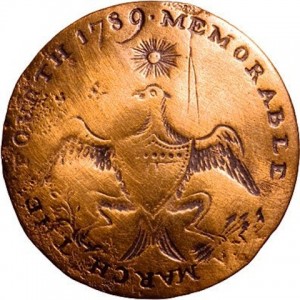
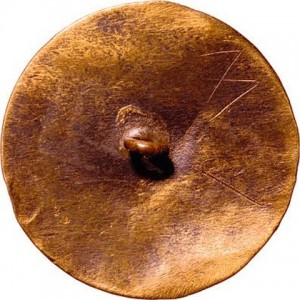
GWI 1-A MARCH THE FOURTH 1789 * MEMORABLE ERA
Color: A High Polished Coppery Brown.
Metal: Flat, 1-Piece, Impressed Design, Copper.
Size: 34mm.
Rarity: R-3
Variety Type: The Pointed 9 Tail.
Present Condition: A Non Excavated Specimen, Good Planchet Condition, A Good Impression Remains.
Obverse Button Analysis: Even though the buttons planchet is in rough shape, it still has some good remaining impressions. The copper planchet’s surface is unfortunately uneven, and shows slight bends and a waviness to it. There also appears to be a poor collaring by the manufacturer of the planchet. The surface shows heavy micro-pitting and porous areas around the edge. There are also heavy scratches and abrasions to the surface. Some appear intentional and some appear to have been caused by an improper cleaning. There is two deep lines at the 12:30 position, along with a planchet depression on the rim. The Eagle’s head and body still have a light outline. There appears to be a loss of inner detail to the eagles feathers in all areas. The Liberty Shield only gives a partial perimeter outline on the left hand side. The right hand side is worn smooth into the surface. The shield’s inner design of the horizontal dots are still present with two missing dots on right hand side. Unfortunately the vertical stripes are mostly worn flat. The Laurel Stem is weakly visible, and the petals are worn smooth into the surface. On a positive, the Bundle of Arrows is clearly shown with some nice detail in the arrow tips, shafts, and nock feathers. The Meridian Sun is still easily recognizable, and shows a clear impression. The 1789, Letter Date, and Catchphrase still have a readable impression. Only the “F”U”R” in FOURTH and the Catchphrases word ERA is worn down. Overall the button has retained a few good characteristics, and still is a pleasing example.
Reverse Button Analysis: This is a flat one-piece button with a soldered on loop shank. The shank is original, straight, and intact. There are some shallow depressions, and three deep scratches to the surface.
Library Records Has Limited Information GWI 1-A-7:
History: Yes Recorded Sales Price: Yes
Current Button Owner and Location: No


GWI 1-A MARCH THE FOURTH 1789 * MEMORABLE ERA
Color: A Greenish-Brassy Brown, with Yellow Over Tones.
Metal: Flat, 1-Piece, Impressed Design, Brass.
Size: 32 mm.
Rarity: R-3
Variety Type: The Pointed 9 Tail.
Present Condition: An Excavated Example, Good Planchet Condition, A Strong Impression Remains.
Obverse Button Analysis: The color of this button is very eye pleasing for being excavated. The planchet is still solid, but does show some irregularities throughout the brass.
The surface has unusual porous lines which gives the button a nice aged look and feel. The surface does show a few light scratches and abrasions, but nothing that affects the design or doesn’t blend in with the color tone. The Eagle still shows a strong strike to the head, body and feathers. Unfortunately, all the inner definition to the eagle is getting worn down from age, but still shows a good image. The Liberty Shield has a nice strong strike, and shows all the dots for the outline clearly. The shield’s inside design of horizontal dots, and vertical stripes is vividly clear. The Laurel Stem unfortunately only shows a light impression, but still does show a clear but faint image. The Bundle of Arrows is also lightly impressed or worn smooth. The image is viewable, but not with good detail. The 1789, the Letter Date, and Catchphrase all show weak impressions that are almost worn into the surface. This button still posses a lot of good traits that would make this a nice memento to own.
Reverse Button Analysis: This is a flat one-piece button with a soldered on loop shank. The shank was broken off harshly. The surface shows metal fatigue, porous areas, decay and corrosion.
Library Records Has Limited Information GWI 1-A-8:
History: Yes Recorded Sales Price: Yes
Current Button Owner and Location: No
From the U. I. “Chick” and Cecilia Harris Collection

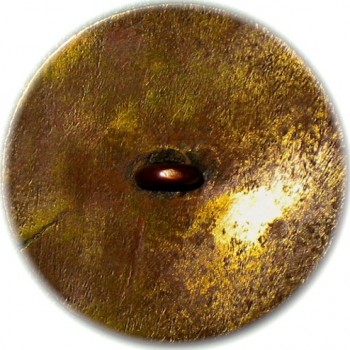
GWI 1-A MARCH THE FOURTH 1789 * MEMORABLE ERA
Color: A Buffed Out Brass with Green Undertones.
Metal: Flat, 1-Piece, Impressed Design, Brass.
Size: 34mm.
Rarity: R-3
Variety Type: The Pointed 9 Tail.
Present Condition: An Excavated Example, Fair Planchet Condition, A Good impression Remains.
Obverse Button Analysis: Why should the Liberty Bell be the only historical artifact to have a crack? Obviously the button shows metal fatigue with a blatant crack in planchet. It travels from the edge through the H in the letter date “March”. The surface shows some porous areas around the edges, and multiple scratches and abrasions from an improper cleaning. On a positive note, the Eagle does retain a nice deep strike impression with a clear image of the head and body. The inner feather detail very sharp in some areas and limited in the wing girth. The Laurel Stem still has a clear image along with the petals. The Bundle of Arrows has a nice deep strike impression, and gives a clear image of the arrow tips, and shafts. The nock feathers are kind of muted and not defined. Unfortunately the Meridian Sun only has a light foot print impression and only portrays a shallow image. The 1789, the Letter Date, and Catchphrase are either to lightly stamped, or worn smooth into the surface. Half of this button has outstanding qualities that i love, and the other half i usually look to avoid. I guess this is my 50/50 button.
Reverse Button Analysis: This is a flat one-piece button with a soldered on loop shank. The shank appears to be original, straight, and intact. The planchet has a crack, and shows some corrosion and pitting. The surface does exhibit some light scratches throughout.
Library Records Has Limited Information GWI 1-A-9:
History: Yes Recorded Sales Price: Yes
Current Button Owner and Location: No
The J. Arminger Collection.~
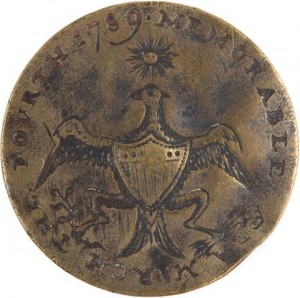
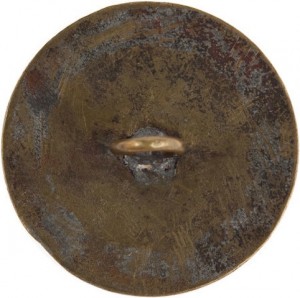
GWI 1-B MARCH THE FOURTH 1789 * MEMORABLE ERA
Color: A Natural Light Brassy Brown with Darkened Overtones.
Metal: Flat, 1-Piece, Impressed Design, Brass.
Size: 34mm.
Rarity: R-3
Variety Type: The 9’s J-Knob Tail.
Present Condition: A Non Excavated Specimen, Good Planchet Casting, A Strong Impression Remains.
Obverse Button Analysis: This button shows remarkable outlines, and clarity to it’s design features. The planchet unfortunately shows a waviness to it’s appearance, and has multiple shallow depressions with some light minor bends along the edge, by the “RA” in ERA. The surface does exhibit some porous areas, and a harsh abrasion under the right wing and around the right leg. The Eagle shows a deep strike with a clear outline of the head, body, and feathers. The inner head and feather details still remain sharp. The Liberty Shield still shows a strong outline, but the inner horizontal dots only show five of the six. There appears to be a flat wear spot in the middle portion of the shield, which could be a protrusion from a re-soldered shank on the reverse. The vertical stripes are present with a faded image within the shield. The Laurel Stem has a nice impression, and still shows all of it’s petals clearly. The Bundle of Arrows shows a good clear image of the tips, shafts, and nock feathers. The Meridian Sun in boldly stamped, and has a clear impression of the Sun’s individual Rays. The 1789, the Letter Date, and Catchphrase are stamped nicely and still easily readable. The button still posses some nice retained traits, and would be a good example for a collector.
Reverse Button Analysis: This is a flat one-piece button with a soldered on loop shank. The shank was reported to be replaced. There surface shows scratches abrasions, and porosity around the periphery.
Library Records Has Limited Information GWI 1-B-10:
History: Yes Recorded Sales Price: Yes
Current Button Owner and Location: No


GWI 1-A MARCH THE FOURTH 1789 * MEMORABLE ERA
Color: Green Marsh Swamp Color With A Gilt Undertone.
Metal: Flat, 1-Piece, Impressed Design, Gilt Brass.
Size: 32 mm.
Rarity: R-3
Variety Type: The Pointed 9 Tail.
Present Condition: An Excavated Example, Good Planchet Condition, A Good Impression Remains.
Obverse Button Analysis: This button has a pleasing dark green color that has some nice remaining deep impressions. The brass planchet shows some environmental discoloration from ground water and shows some corrosion. Unfortunately, there is a diagonal upward bend in the planchet that runs from the 1 o’clock to 3 o’clock position. The good thing is that the surface is blessed with no deep scratches or harsh abrasions. The Eagle still retains a good deep strike impression for the outline of the head, body, and feathers. The inner feather detail in the wings and neck is nicely highlighted with gilt. Unfortunately, the legs and talons are worn down and only portray a light foot impression. The Liberty Shield’s perimeter dots are weak, but still hold a good image. The shield’s inner design of the horizontal dots and vertical stripes are still viewable, but are worn smooth in spots. The Laurel Stem has a partial image and the petals retain a light foot print impression. The Bundle of Arrows is unfortunately worn smooth into the surface, and only has a very faint image. The Meridian Sun and it’s individual Rays only shows an outline from the original impression. The 1789, the Letter Date, and Catchphrase are either stamped too lightly, or worn smooth into the surface. This button is a nice find for a treasure hunter and makes a good memento for someone who likes George Washington memorabilia.
Reverse Button Analysis: This is a flat one-piece button with a soldered on loop shank. The shank appears to be twisted, and re-attached professionally. The surface shows some light corrosion along with being porous.
Library Records Has Limited Information GWI 1-A-10:
History: Yes Recorded Sales Price: Yes
Current Button Owner and Location: No
*

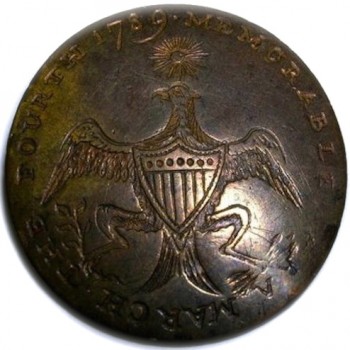
GWI 1-B MARCH THE FOURTH 1789 * MEMORABLE ERA
Color: A Natural Golden Brass or A Greenish-Brown Patina?
Metal: Flat, 1-Piece, Impressed Design, Brass.
Size: 34mm.
Rarity: R-5
Variety Type: The 9’s J-Knob Tail.
Present Condition: A Non Excavated Specimen, Strong Planchet Condition, A Strong Impression Remains.
Obverse Button Analysis: Which button’s condition do you prefer? This button originally had a wonderful natural patina. Unfortunately, someone took it upon themselves to use a buffing wheel and oil in hopes of flipping it for a profit. This is why there is a shade variation between the two sales of this specimen. The brass planchet is flat and smooth with no metal fatigue or deterioration. The surface was well preserved with only a few light scratches that seem to have blended right into the color mix. The Eagle shows a strong deep outline impression of the head, body and inner feathers. The only imperfection is the left talon, it displays a lighter impression from the die strike. The Liberty Shield shows a nice deep outline strike, but the outside perimeter dots appear to be muted into each other. The shield’s inner detail of the horizontal dots and vertical stripes are superbly displayed with clarity. The Laurel Stem retains a nice impression, and gives a sharp image of all the petals. The Bundle of Arrows has a good strike image, but the shafts appear to be worn smooth into the surface along with the Eagle’s talon. The Arrow’s tips and nock feathers are nicely shown. The Meridian Sun and it’s individual Rays, shows a strong strike with all clear individual lines. The 1789, the Letter Date, and Catchphrase all show a strong impression and is easy to read. This button is in great condition, and should be considered a prize in anyone’s GW Collection.
Reverse Button Analysis: This is a flat one-piece button with a soldered on loop shank. This appears to be a later date replacement shank. There are a few minor surface nicks and possibly a few light scratches. There is also a small triangle pit in the planchet on the rim, but could also be the color shade.
Library Records Has Limited Information GWI 1-B-11:
History: Yes Recorded Sales Price: Yes
Current Button Owner and Location: No


GWI 1-A MARCH THE FOURTH 1789 * MEMORABLE ERA
Color: A Rich Shoe Polish Brown, with some Traces of Light Brown.
Metal: Flat, 1-Piece, Impressed Design, Copper.
Size: 34mm.
Rarity: R-3
Variety Type: The Pointed 9 Tail.
Present Condition: A Non Excavated Specimen, Good Planchet Consition, A Good Impression Remains.
Obverse Button Analysis: A nicely aged button with most of it’s impressions still visible. The planchet has a slight waviness around the edge, and shows metal loss and damage on the reverse. The surface reportedly has some shallow depressions and slight bends in the planchet. Fortunately, there appears to be no harsh scratches or abrasions effecting the buttons designs. The Eagle’s outline only shows a shallow image for the head, body and feathers. There is some modest traces of the inner feather detail, but most is faint. The Liberty Shield’s outline remains with only half of the perimeter dots remaining. The shield’s inner design still depicts the horizontal dots, but the vertical stripes are mostly worn smooth into the surface. The Laurel Stem and it’s petals have a light footprint, but does depict the shape of the petals. The Eagle’s left Talon and Bundle of Three Arrows is almost completely worn smooth with only the faintest trace outlines. The Meridian Sun and it’s Rays still has a clear viewable image. The 1789 and the Letter Date still still have a clear letter image with a nice deep impression. Unfortunately, only the word MEMORABLE is readable for the Catchphrase. The word ERA is completely worn flat into the surface.
Reverse Button Analysis: This is a flat one-piece button with a soldered on loop shank. The shank was broken off but smoothed out with a file. The surface shows numerous tool file marks and scratches.
Library Records Has Limited Information GWI 1-A-11:
History: Yes Recorded Sales Price: Yes
Current Button Owner and Location: No

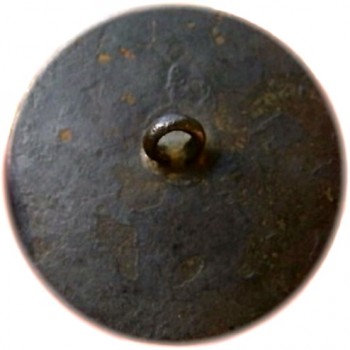
GWI 1-A MARCH THE FOURTH 1789 * MEMORABLE ERA
Color: A Nice Chocolate Brown Patina with Dark Black Highlights.
Metal: Flat, 1-Piece, Impressed Design, Copper.
Size: 34mm.
Rarity: R-3
Variety Type: The Pointed 9 Tail.
Present Condition: An Excavated Example, Strong Planchet Condition, A Strong Impression Remains.
Obverse Button Analysis: This button has a nice rich surface color. The copper planchet exhibits some decay and metal fatigue. The surface is rough with porous areas from ground water. There is also some microporosity and minor pitting. On a positive note, the Eagle has a strong strike with a clear outline impression of the head, and body. All the inner feather detail is strong and it’s impressions remain intact. The legs do show a moderate stamp, but the image is still easily seen. The Liberty Shield has some environmental damage and pitting. There is a smoothing out on the right hand side, and the perimeter dots are weak. The shield’s inner horizontal dots still have a lasting impression, but the horizontal stripes are marred with pits and down. The Laurel Stem shows a nice deep strike, and gives a clear image to all the individual petals. The Bundle of Arrows still have a good impression, with a clear image of the tips, shafts, and nock feathers. The Meridian Sun and it’s Rays unfortunately only exhibits a light foot print for an impression, but it’s image is still easily seen. The 1789, the Letter Date, and the Catchphrase still retain a good strike with a nice shallow impressions, except for the “U, R, T in the Fourth. They are almost worn smooth into the surface. Overall the button retains a lot of strong solid attributes, the only thing i don’t like is the condition of the copper planchet used due to years of ground action.
Reverse Button Analysis: This is flat a one-piece button with a soldered on loop shank. The shank is original, straight and intact. The brass planchet does show some edge loss, and the surface shows to be slightly corroded with porous areas throughout.
Library Records Has Limited Information GWI 1-A-12:
History: Yes Recorded Sales Price: Yes
Current Button Owner and Location: No
GWI 1-A MARCH THE FOURTH 1789 * MEMORABLE ERA
Color: An Orange-Brown Copper Patina.
Metal: Flat, 1-Piece, Impressed Design, Copper.
Size: 34mm.
Rarity: R-3
Variety Type: The Pointed 9 Tail.
Present Condition: An Excavated Example, Fair Planchet Condition, A Fair Impression Remains.
Obverse Button Analysis: This is a very rough example which the passage of time has not been good to. The softer copper planchet shows extreme metal fatigue and corrosive properties. The surface has shallow depressions and is somewhat coarse to the touch because of all the scratches and abrasions. It also has been improperly cleaned many times over the centuries, and it shows light scratches from the cleaning cloth. The Eagle’s head does show a vague outline for the eye and the beak. The left wing is obscured by environmental erosion and the left leg is worn flat into the surface. The Liberty Shield only shows a partial image on the right hand side and the left is worn flat into the surface. The shield’s inner horizontal dots still boldly show except for the last one which only has a light footprint. Unfortunately, only three of the six vertical stripes remain intact. The rest of the lines are worn smooth into the surface or corroded. The Laurel Stem and it’s petals is the buttons strongest feature. It still shows a nice deep strike impression, and a clear image of all it’s petals. The Bundle of Arrows are almost completely absent, except for a muted remnant impression of the nock feathers. The Meridian Sun and it’s Rays only has a vague muted image with light scratches overing over. The 1789 and Letter Date still holds a nice impression, and is still easily readable. The Catchphrase unfortunately only retains part of the word MEMORABLE, and remnants of the word ERA. I believe this was the first button i ever sold out of my collection, maybe even the first copper specimen of this variety I ever purchased.
Reverse Button Analysis: This is flat a one-piece button with a soldered on loop shank. The shank was roughly broken off with left over nub remnants. The surface shows corrosion, decay and micro porosity throughout.
Library Records Has Limited Information GWI 1-A 13:
History: Yes Recorded Sales Price: Yes
Current Button Owner and Location: Yes
Excavated from York/Redding Pennsylvania.~
Previously from the Isabela Collection.~
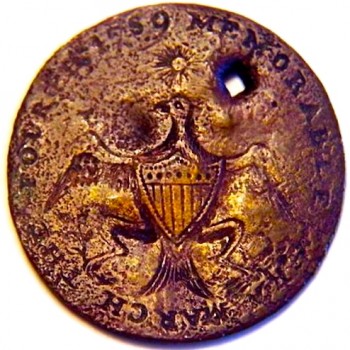
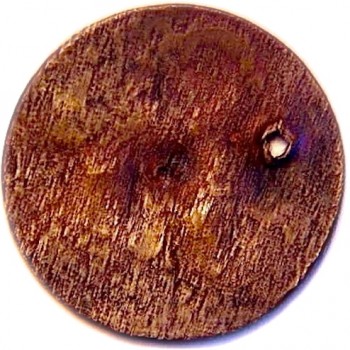
GWI 1-A MARCH THE FOURTH 1789 * MEMORABLE ERA
Color: A Light Yellowish-Brown Patina.
Metal: Flat, 1-Piece, Impressed Design, Copper.
Size: 34mm.
Rarity: R-3
Variety Type: The Pointed 9 Tail.
Present Condition: An Excavated Example, Fair Planchet Condition, A Good Impression Remains.
Obverse Button Analysis: Even being buried for countless years, this button still has a good impressions and shows a nice eagle design. The copper planchet shows serious metal fatigue, decay, and an artificial nail hole at 1 o’clock position. The surface has a multitude of sins including: corrosion, deep porous areas, shallow depressions above the wings, microporsity, and pitting throughout. The Eagle’s head, body, and feathers surprisingly still have a deep outline impression with a decent image. There is even some some clear inner details of the head and feathers. The Liberty Shield shows a deep strike with nice viewable image of the outside perimeter dots. All the shield’s inner horizontal dots, and vertical stripes are displayed with a clear image. That is most likely the strongest design of the button. The Laurel Stem and petals still retains a shallow worn image. The Bundle of Arrows has a trace outline of the nock feathers, shafts, and arrow tips. The Meridian Sun and it’s individual Rays only has a light impression, and the Rays are mostly worn smooth into the surface on one side. The 1789, Letter Date, and Catchphrase are decayed from ground action, but is still readable.
Reverse Button Analysis: This is flat a one-piece button with a soldered on loop shank. The shank is missing. The surface is extremely corroded, pitted and porous in nature.
Library Records Has Limited Information GWI 1-A-14:
History: Yes Recorded Sales Price: Yes
Current Button Owner and Location: No
|
|
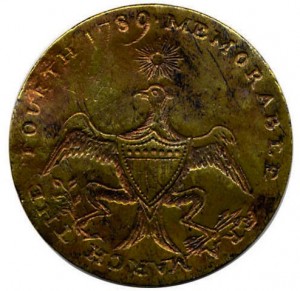
GWI 1-A MARCH THE FOURTH 1789 * MEMORABLE ERA
Color: A Naturally Toned Golden Brass.
Metal: Flat, 1-Piece, Impressed Design, Brass.
Size: 34mm.
Rarity: R-3
Variety Type: The Pointed 9 Tail.
Present Condition: A Non Excavated Specimen, Exceptional Planchet Condition, An Exceptional Impression Remains.
Obverse Button Analysis: This is an exceptional specimen that has been preserved quite nicely. The brass planchet shows no signs of metal fatigue, decay or corrosion. The surface has some minor light scratches in the upper right field, but are practically undetectable. The seller has noted a very shallow surface indentation that probably could only be felt. The Eagle shows a deep strike with a clear outline of the head, and the body. The inner feather details in the head and body show a clear sharp image. The Liberty Shield has a strong strike, with a clear image of all the individual perimeters dots. The shield’s inner horizontal dots have a nice deep strike without any wear. Unfortunately, the vertical strips only depict a light foot print. The Laurel Stem is also nicely stamped with a clear image of all it’s petals. The Bundle of Arrows is magnificently impressed, and shows in perfect detail the arrow tips, shafts, and nock feathers. (This Bundle of Arrows could possibly be one of the finest example known). The 1789, Letter Date, and Catchphrase medium foot print impression, but is easily readable with clean letter lines. Except for the buttons few light impressions, i find this to be an excellent example that would be a Jewel in anyone’s GW collection.
Reverse Button Analysis: This is flat a one-piece button with a soldered on loop shank. It was reported that the original shank was professionally restored. The surface was noted to also have some very light abrasions that are hardly noticeable.
Library Records Has Limited Information GWI 1-A-15:
History: Yes Recorded Sales Price: Yes
Current Button Owner and Location: No

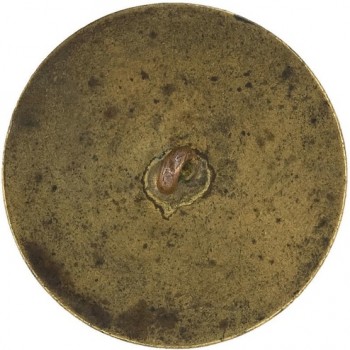
GWI 1-B MARCH THE FOURTH 1789 * MEMORABLE ERA
Color: Antique Brass.
Metal: Flat, 1-Piece, Impressed Design, Brass.
Size: 34mm.
Rarity: R-5
Variety Type: The 9’s J-Knob Tail.
Present Condition: A Non Excavated Specimen, Excellent Planchet Condition, An Exceptional Impression Remains.
Obverse Button Analysis: This is a great specimen for the GWI 1-B Knob Tail. The surface color of the brass has a shaded patina from it’s age. The brass planchet is smooth and flat without any waviness or shallow impressions. The surface is free of any ground action, abrasions or scratches. The eagle exhibits a nice strong strike impression with a clear image of it’s features. The inner feather detail is strong. Only the legs show a light foot print which is probably the result of a weak die strike during fabrication. The left talon is worn smooth into the surface along with the arrow shafts. The Bundle of Arrows has a clear image of the tips and a partial for the knock feathers. The Laurel Stem ha a strong strike and a good clear image of it’s petals. The eagle’s shield is its weakest point. Event hough outlined nicely, the perimeter dots are worn on the left hand side. the inner dots appear to be worn and the vertical lines are worn flat into the surface. The 1789, and Letter Date show good strong strikes with good clean letter lines that are easy to read. The catchphrase is strong except for the word “ERA” with is worn smooth into the surface. The Meridian Sun still retains a strong strike with a clear image. Overall a great button for a collector of GW’s.
Reverse Button Analysis: This is flat a one-piece button with a soldered on loop shank. It was reported that the original shank was professionally restored. The surface was noted to also have some very light abrasions that are hardly noticeable.
Library Records Has Limited Information GWI 1-B-14:
History: Yes Recorded Sales Price: Yes
Current Button Owner and Location: No
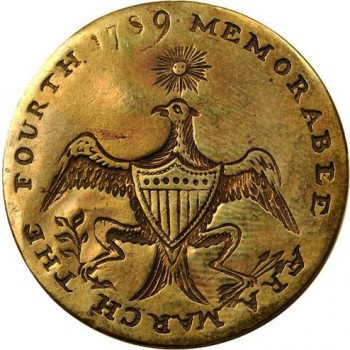
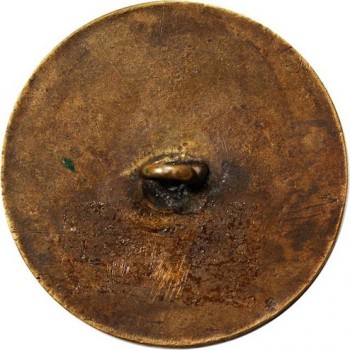
GWI 1-A MARCH THE FOURTH 1789 * MEMORABLE ERA
Color: A Nice Iridescent Brass Yellow With Touches of Orange.
Metal: Flat, 1-Piece, Impressed Design, Gilt Brass.
Size: 34mm.
Rarity: R-3
Variety Type: The Pointed 9 Tail Variety.
Present Condition: A Non Excavated Example, Excellent Planchet Condition, An Exceptional Impression Remains.
Obverse Button Analysis: This is another wonderful specimen that is in near mint condition. The brass planchet appears to be flawless, and shows no metal fatigue, decay, or deterioration. The surface might have been lightly cleaned, but has nicely re-toned with an iridescent color-mix. The only surface flaw i see is a slight abrasion under the left wing. The Eagle depicts a nice deep strike outline, and has a crystal clear image of the eagles ‘s head, body and inner feathers. The Liberty Shield also depicts a strong perimeter outline showing all the individual dots. The shield’s inner horizontal dots, and vertical stripes are also boldly shown with a nice clear image. The Laurel Stem has a good impression with all the individual petals unmarred. As with most in this variety, the Bundle of Arrows only depicts a light foot print impression. This specimen has a good depiction of all the arrow tips, shafts, and nock feathers. The Meridian Sun and all it’s rays retain a strong strike with a clear image. The 1789 depicts a light foot print, but the Letter Date and Catchphrase has a nice deep impression that is easy to read. This button is a Jewel!
Reverse Button Analysis: This is flat a one-piece button with a soldered on loop shank. The shank is original, shank, and intact. The surface retains its full original luster, and has no scratches or abrasions.
Library Records Has Limited Information GWI 1-A-16:
History: Yes Recorded Sales Price: Yes
Current Button Owner and Location: No
GWI 1-A MARCH THE FOURTH 1789 * MEMORABLE ERA
Color: An Aged Silvery Grey with A Black Undertone.
Metal: Flat, 1-Piece, Impressed Design, Silver-Wash Copper.
Size: 34 mm.
Rarity: R-3
Variety Type: The Pointed 9 Tail.
Present Condition: An Excavated Example, Good Planchet Condition, An Exceptional Impression Remains.
Obverse Button Analysis: This is one of two surviving Silver-Wash examples i know of. I am very happy to see that all the steel die impressions are still clear. The copper planchet unfortunately show signs of metal fatigue, corrosion, microporosity, and pitting. The porous areas probably are the result of ground water. On a positive note, there are no scratches or harsh abrasions effecting any of the button’s designs. The Eagle shows a nice deep strike with a clear outline of the head, and body. All the inner feather detail still have a clear image from their original die strike. The Liberty Shield has a strong strike for the perimeter’s dotted outline. All the shield’s inner horizontal dots and vertical stripes of are clearly depicted. The Laurel Stem has a nice impression, and has a good image of the petals. The Bundle of Arrows depicts a nice imprint, but doesn’t allow for a clear depiction of the arrow tips, shafts, or nock feathers. The Meridian Sun has a nice deep strike, and a clear image of the individual lines for the sun’s rays. The 1789, the Letter Date, and Catchphrase all show a strong deep letter impression, and are easy to read. Obviously this button was excavated in some kind of sandy soil to retain these characteristics so well. This is a true prize for a treasure hunter, and still a gem for a GW collector.
Reverse Button Analysis: This is flat a one-piece button with a soldered on loop shank. The shank is missing. The surface was reported to have “Tarnished to a Black Finish”.
Library Records Has Limited Information GWI 1-A-17:
History: Yes Recorded Sales Price: Yes
Current Button Owner and Location: No
GWI 1-A MARCH THE FOURTH 1789 * MEMORABLE ERA
Color: A Nicely Aged Dark Brass.
Metal: Flat, 1-Piece, Impressed Design, Brass.
Size: 34mm.
Rarity: R-3
Variety Type: The Pointed 9 Tail.
Present Condition: A Non Excavated Specimen. Exceptional Planchet Condition, A Strong Impression Remains.
Obverse Button Analysis: The surface has a nice natural deep golden brass colour. The planchet is smooth and flat, and shows no signs of metal fatigue or deterioration. The surface has a few light scratches and color blemishes scattered around the field, but nothing that detracts from the button’s design or charm. The Eagle shows a nice deep strike with a clear outline of the head and body. The Eagle’s inner feather detail is still clearly depicted. The Liberty Shield’s outline shows a nice outline, but lacks a strong clarity for the individual perimeter dots. The shield’s inner horizontal dots and verticals stripes depict a clear image, but lacks a strong impression. The Laurel Stem and it’s Petals depict a light foot print, but still have a nice clear image. The Bundle of Arrows also lacks a deep strike. The arrow tips, and nock feathers are shallowly visible as with the shafts. The Meridian Sun has a deep strike with good depth, and has a clear image of all the Ray’s individual lines. The 1789, and Letter Date have straight letter lines that are still easily read. The Catchphrase is readable, but the “E” in Memorable, and the word “ERA” appear to be worn into the surface or shallow. Overall this is a great specimen with exceptional color.
Reverse Button Analysis: This is flat a one-piece button with a soldered on loop shank. The Original shank is noted to be intact by the seller.
Library Records Has Limited Information GWI 1-A-18:
History: Yes Recorded Sales Price: Yes
Current Button Owner and Location: No
GWI 1-A MARCH THE FOURTH 1789 * MEMORABLE ERA
Color: A Deep Rich Reddish-Brown Color.
Metal: Flat, 1-Piece, Impressed Design, Burnished Copper.
Size: 34mm.
Rarity: R-3
Variety Type: The Pointed 9 Tail.
Present Condition: A Non Excavated Specimen, Good Planchet Condition, A Fair Impression Remains.
Obverse Button Analysis: This button shows a light burnishing which definitely adds to it’s dynamics. If you scroll up to A-10 you would even think this is the same button because of the color and finger wear, but under scrutiny you can see one button’s shield still retains the lines. The planchet is solid and flat, and shows no signs of metal distress from ground action. The surface is smooth and flat without any scratches or heavy abrasions, but parts around the rim appear a bit microporous. The Eagle unfortunately shows wear, and lacks a strong outline impression. The inner details of the legs and wings are worn smooth into the surface, and the Eagle’s talons are almost completely absent from the original design. The Liberty Shield is still recognizable, but lacks a good portion of the upper perimeter’s dots. The shield’s inner horizontal dots only have 2 remnants of the original seven, and vertical stripes are mostly non existent and worn smooth into the surface. The Meridian Sun still shows a partial image, but it’s Rays are missing on one side entirely. The 1789, the Letter Date, and Catchphrase is mostly worn smooth into the surface and barely readable except for MARCH, THE and most of MEMORABLE . This is a nice button for someone who is just starting a GW collection or just wants one as a special memento.
Reverse Button Analysis: This is flat a one-piece button with a soldered on loop shank. The shank was reportedly replaced by H.A. The surface is smooth and free of any scratches.
Library Records Has Limited Information GWI 1-A-19:
History: Yes Recorded Sales Price: Yes
Current Button Owner and Location: No
GWI 1-B MARCH THE FOURTH 1789 * MEMORABLE ERA
Color: A Rich Golden Hue With Flecks of Red.
Metal: Flat, 1-Piece, Impressed Design, Gilt Brass.
Size: 34mm.
Rarity: R-5
Variety Type: The 9’s J-Knob Tail.
Present Condition: A Non Excavated Specimen, Exceptional Planchet Condition, An Exceptional Impression Remains.
Obverse Button Analysis: This is a great example that has been well preserved through the years. The planchet is solid and flat, and shows no signs of metal fatigue or deterioration from ground action. The surface is nice and smooth with no pitting or porous areas. There appears to be a few light scratches under the right wing, and above the right leg, but they have blended in with the color of the patina. The Eagle shows a nice deep strike, and gives exceptional detail to the head, body, and the inner feathers. The Liberty Shield shows a strong strike impression for the outline, and all the perimeter dots. The shield’s inner horizontal dots and vertical stripes only has a light foot print, but still shows a nice viewable image. The Laurel Stem has a good impression, and shows all the individual petals clearly. The Bundle of Arrows unfortunately lacks a strong strike detail for the shafts and tips, but the nock feather’s outline is still easily seen. The Meridian Sun is nice and bold, and shows all the individual Rays clearly. The 1789, and Letter Date, still have a nice deep impression with clear letter lines that are easy to read. The Catchphrase is still mostly readable but for the “E” in Memorable, and the word “ERA”. This appears to have been worn smooth into the surface, or lack a deep die strike. This is a wonderful button with some eye catching color.
Reverse Button Analysis: This is flat a one-piece button with a soldered on loop shank. The original shank was reported to be intact. The surface has a few minor abrasions.
Library Records Has Limited Information GWI 1-B-15:
History: No Recorded Sales Price: No
Current Button Owner and Location: No

GWI 1-A MARCH THE FOURTH 1789 * MEMORABLE ERA
Color: A Natural Chocolate Brown with Mustard Yellowish Highlights.
Metal: Flat, 1-Piece, Impressed Design, Copper.
Size: 34mm.
Rarity: R-3
Variety Type: The Pointed 9 Tail.
Present Condition: An Excavated Example, Good Planchet Condition, An Exceptional Impression Remains.
Obverse Button Analysis: This is a nice dug specimen. The Copper planchet is still solid, but shows some shallow depressions and waviness to the surface. Fortunately, the planchet also shows no signs of metal loss, deterioration or decay from ground action. The surface shows some minor scratches above the right wing, but nothing that effects the design of the wing itself. The Eagle has a nice deep stamp, and shows good inner detail to the head, body and feathers (As far as impressions go, this might be one of the top 2 Best Dug Examples). The Liberty Shield has a nice strong strike, and shows a strong outline of the perimeter dots. All the shield’s inner horizontal dots and vertical stripes have a strong impression with a clear image. The Laurel Stem also has a nice impression, and gives a clear image to all the individual petals. The Bundle of Arrows is amazingly stamped deep with a crystal clear image of the shafts, tips, and nock feathers. The Meridian shows a deep strike with good clarity to all the individual Rays. The 1789, Letter Date, and Catchphrase all show a nice deep strike impression that is easy to read. Overall this is a superior example that could hold it’s own against a Non Excavated specimen any day of the week. This would make a great addition to anyone’s GW Collection.
Reverse Button Analysis: This is flat a one-piece button with a soldered on loop shank. No information on shank or surface.
Library Records Has Limited Information GWI 1-A-20:
History: Yes Recorded Sales Price: None
Current Button Owner and Location: ~ Indiana~
*Excavated in October 2010.~

GWI 1-B MARCH THE FOURTH 1789 * MEMORABLE ERA
Color: A Deep Rich Golden Brass Patina.
Metal: Flat, 1-Piece, Impressed Design, Gilt Brass.
Size: 34mm.
Rarity: R-3
Variety Type: The 9’s J-Knob Tail.
Present Condition: A Non Excavated Specimen, Strong Planchet Condition, An Exceptional Impression Remains.
Obverse Button Analysis: Unfortunately this picture is pixilated in the photo, but it still posses some nice impressions and great natural toning. The planchet unfortunately shows metal fatigue by a raised shank protrusion from the reverse. The brass appears to have discolored on the obverse from the heat burns when the shank was repaired or re-attached. This usually happens when the metal gets overheated while being improperly soldered. Other then that major blemish, there appears to be no decay or deterioration to the brass planchet. The surface is mostly smooth, and only shows a few light scratches that blend into the color shade. Except for the neck, the Eagle has a nice deep strike and shows good detail for the body and feathers. The inner detail of the feathers is exceptional. The head does show the eye and beak, but it’s neck suffers from the shank protrusion. The Liberty Shield still has a strong outline with all the dots and stripes, but unfortunately the protrusion ruins the upper portion of the shields design. The Laurel Stem has a nice deep strike, and shows all the petals clearly. The Bundle of Arrows has a bold strike, and gives a good clear image of the tips, shafts, and nock feathers. The Meridian Sun is also nicely stamped with a clear image of all the Rays. The 1789 Date, Letters Date and Catchphrase show all deep letter strikes with clear straight letter lines. From the exceptionally deep impressions, this would be one of the best examples known. Unfortunately the shank protrusion takes that honor away.
Reverse Button Analysis: This is flat a one-piece button with a soldered on loop shank. No information provided on the shank or surface.
Library Records Has Limited Information GWI 1-A-16:
History: No Recorded Sales Price No
Current Button Owner and Location: No

GWI 1-A MARCH THE FOURTH 1789 * MEMORABLE ERA
Color: A Naturally Toned Rich Coppery-Brown.
Metal: Flat, 1-Piece, Impressed Design, Copper.
Size: 34mm.
Rarity: R-3
Variety Type: The Pointed 9 Tail.
Present Condition: A Non Excavated Specimen, Excellent Planchet Condition, An Exceptional Impression Remains.
Obverse Button Analysis: This button is in mint-museum quality condition. The planchet is solid and flat, and shows no signs of metal fatigue or deterioration from ground action. The color shade is even and consistent throughout the whole surface of the button. The surface is smooth to the touch, and shows no scratches or abrasions. The Eagle has a strong strike impression with a clear outline of the head, body and inner feathers. The Liberty Shield also has a strong strike that gives an excellent image to all the perimeter dots, as well as the inner horizontal dots and vertical stripes. The Laurel Stem has a good impression, with a nice outline of all the individual petals. The Bundle of Arrows shows a strong strike, and an extremely clear depiction of the all the tips, shafts, and nock feathers. The Meridian Sun also has a bold impression that shows all its individual rays clearly. The 1789 Date, Letter Date, and Catchphrase depict nice deep letter lines that are easy to read. The only two exceptions, are the “7” in 1789, and the “H” in MARCH. They have a weak strike impression from the original fabrication die cut. Otherwise this an outstanding copper example, and probably one of the finest known in this variety.
Reverse Button Analysis: This is flat a one-piece button with a soldered on loop shank. The shank is original, straight and intact. No scratches, abrasions or blemishes reported.
Library Records Has Limited Information GWI 1-A-21:
History: No Recorded Sales Price: No
Current Button Owner and Location: Yes
The R. Becker Collection.~

GWI 1-A MARCH THE FOURTH 1789 * MEMORABLE ERA
Color: A Polished Greenish-Yellow-Brown.
Metal: Flat, 1-Piece, Impressed Design, Brass.
Size: 34mm.
Rarity: R-3
Variety Type: Pointed 9 Tail Variety.
Present Condition: An Excavated Example, Poor planchet Casting, A Poor Impression Remains.
Obverse Button Analysis: An excavated example that has barely stood the test of time. The planchet exhibits metal fatigue, decay and deterioration. The button shows shallow depressions and bends throughout the surface. The button was probably buffed to a high polish after being excavated by the treasure hunter to see the design better. The Eagle only shows a faint outline of it’s body parts, and shows very little inner detail. The feathers in the right wing appear to be it’s best remaining detail, even though some images remain in the left wing and tail feathers. The Liberty Shield only demonstrates a shallow outline with the lower perimeter dots intact. The inner horizontal dots only show scarce remnants. The vertical stripes show three of the original seven lines, the rest are worn into the surface. The Laurel Stem still shows a shallow outline with all of it’s petals. The Bundle of Arrows only vague lines of it’s original impressions. The Meridian Sun only shows a very faint impression. The 1789, Letter Date, and Catchphrase is mostly worn smooth into the surface or barely readable. Only the words “March & The” have some lasting impressions for reading.
Reverse Button Analysis: This is flat a one-piece button with a soldered on loop shank. No information on shank or surface.
Library Records Has Limited Information GWI 1-A-22:
History: Limited Recorded Sales Price: No
Current Button Owner and Location: No
Excavated by Lance in August 2005*
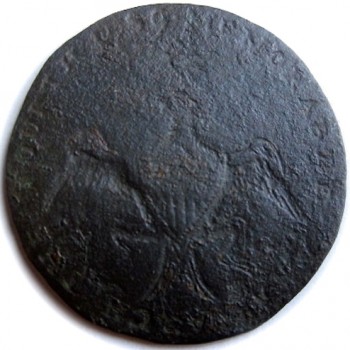
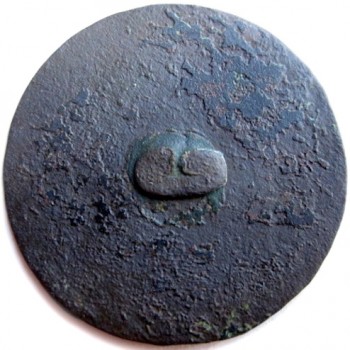
GWI 1-A MARCH THE FOURTH 1789 * MEMORABLE ERA
Color: A Dark Earth Brown.
Metal: Flat, 1-Piece, Impressed Design, Copper.
Size: 34mm.
Rarity: R-3
Variety Type: Pointed 9 Tail Variety.
Present Condition: An Excavated Example, Poor Planchet Condition, A Fair Impression Remains.
Obverse Button Analysis: All the tell tale signs of being in the ground for 200 years is exhibited here. The copper planchet is corroded from ground action, and shows numerous porous areas that blanket the surface. Fortunately, there appears to be no heavy scratches or gouges affecting the button’s designs. The Eagle is still lightly outlined, but due to erosion it gives no clarity to the inner body parts or it’s feathers. The Liberty Shield is almost worn away except for partial remnants of the inner vertical lines, and the perimeter dots on the left hand side. The Laurel Stem only has a faintest outline remaining. The Bundle of Three Arrows is unfortnately hard to decipher in the actual image. Only a light foot print remains of the Meridian Sun and it’s Rays. The 1789, Letter Date, and Catchphrase letters are decayed from ground action. This is a rough example, but should still be prized for a metal detector find.
Reverse Button Analysis: This is flat a one-piece button with a soldered on loop shank. The original shank is crushed flat. The surface shows corrosion and porosity.
Library Records Has Limited Information GWI 1-A-23:
History: Yes Recorded Sales Price: Digger Owner
Current Button Owner and Location: ~ Waterbury, CT ~
Heavy Metal Nut Dave Wise’s 2nd GW find. (1 of 10)
Excavated in Upstate NY/Connecticut October 23, 2010*
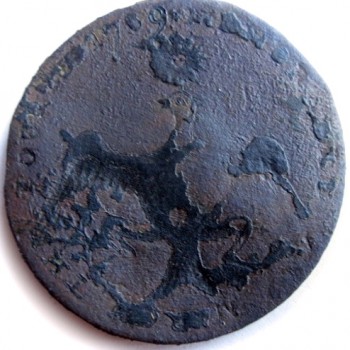

GWI 1-A MARCH THE FOURTH 1789 * MEMORABLE ERA
Color: A Combo of Black and Brown.
Metal: Flat, 1-Piece, Impressed Design, Copper.
Size: 34mm.
Rarity: R-3
Variety Type: Pointed 9 Tail Variety.
Present Condition: An Excavated Example, Poor Planchet Condition, A Fair Impression Remains.
Obverse Button Analysis: This is another GW button dave dug. Kudos to the man with 10 GW finds under his belt. This obviously has all the tell tale signs of being in the ground with the presence of groundwater. The brass planchet is corroded, and the planchet is wavy and bent. Fortunately, the button doesn’t have any heavy scratches or gouges on the surface. The Eagle is scantly outlined, but gives no clarity to the inner body parts or it’s inner feather features. The Liberty Shield is mostly flat and smooth. The Laurel Stem shows a traceable outline from it’s former original impression. The Bundle of Three Arrows is hard to decipher it’s true image. The Meridian Sun and it’s Rays is crusted over, but has a traceable outline. The 1789, Letter Date, and Catchphrase is barely readable without letter strength or identification.
Reverse Button Analysis: This is flat a one-piece button with a soldered on loop shank. The original shank is crushed flat. The surface shows corrosion and porosity.
Library Records Has Limited Information GWI 1-A-24:
History: Yes Recorded Sales Price: Digger Owner
Current Button Owner and Location: ~ Waterbury, CT ~
Another Dug by Heavy Metal Nut Dave Wise (2 of 10)
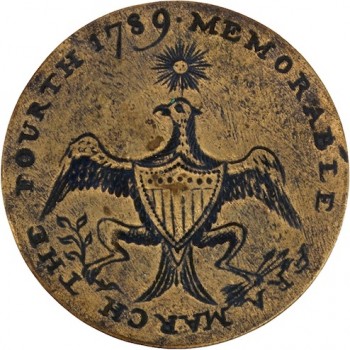

GWI 1-B MARCH THE FOURTH 1789 * MEMORABLE ERA
Color: An Aged Brass W/ Black Highlights.
Metal: Flat, 1-Piece, Impressed Design, Copper.
Size: 34mm.
Rarity: R-3
Variety Type: The 9’s J-Knob Tail.
Present Condition: An Excavated Example, Exceptional Planchet Casting, A Strong Impression Remains.
Obverse Button Analysis: This is a great specimen illustrating the rarer “Knob Tail” variety. The copper planchet show no signs of metal fatigue, corrosion, or decay. The surface is mostly smooth and flat, but does have a few small scratches or abrasions. The Eagle shows a nice strong strike impression, and gives a good clear image of the head, body and feathers. The Liberty Shield shows a strong strike with a clear outline of all the perimeter dots. All the inner horizontal dots and vertical stripes are clearly visible with very little wear or decay. The Laurel Stem shows a nice deep strike with a clear image of the stem, and all the individual petals. The Bundle of Arrows has a good deep impression, and shows the shafts, tips, and nock feathers with clarity. The Meridian Sun has a strong strike, and all it’s individual Rays are clearly shown. The 1789 Date, the Letter Date, and Catchphrase are clearly readable with clean straight letter lines. Overall this is another excellent knob tail example.
Reverse Button Analysis: This is flat a one-piece button with a soldered on loop shank. The shank is original, straight and intact.
Library Records Has Limited Information GWI 1-B-17:
History: No Recorded Sales Price: Yes
Current Button Owner and Location: No
Previous to 2015, The Merrill C. Berman Collection.

GWI 1-A MARCH THE FOURTH 1789 * MEMORABLE ERA
Color: A Naturally Toned Copper with Mustard Yellow Splashes.
Metal: Flat, 1-Piece, Impressed Design, Copper.
Size: 34mm.
Rarity: R-3
Variety Type: The Pointed 9 Tail.
Present Condition: A Non Excavated Specimen, Exceptional Planchet Condition, An Exceptional Impression Remains.
Obverse Button Analysis: This is one of Cobb’s buttons that is a Copper specimen. This soft copper planchet show no signs of metal fatigue, corrosion, or decay from ground action. The surface is smooth and flat and has no scratches or abrasions effecting it’s design. The Eagle shows a nice strong strike impression, and gives a crystal clear image of the head, body and inner feathers. The inner details of the body’s feathers appears to be better then most. The Liberty Shield shows a strong strike impression and shows a clear outline of all the perimeter dots. The shield’s inner horizontal dots and vertical stripes are all nicely stamped and show little wear. The Laurel Stem also has a nice deep strike, and gives a crystal clear image of the stem, and all the individual petals. The Bundle of Arrows has a good impression for the tips, and nock feathers, but the shafts lack a strong impression. The Meridian Sun has a strong strike, and all it’s individual Rays are clearly shown. The 1789 Date is partially worn smooth, or lacks a deep die strike in the “1,7,& 8”, but the “9” still holds a recognizable impression. The Letter Date and Catchphrase shows a nice deep strike impression with clear straight letter lines which are easy to read. Overall this is another excellent copper example.
Reverse Button Analysis: This is flat a one-piece button with a soldered on loop shank. The shank was reported to be original, straight and intact.
Library Records Has Limited Information GWI 1-A-25:
History: Yes Recorded Sales Price: Yes
Current Button Owner and Location: No
Purchased in 1960 from F. Nichols/ Ball ~
Harold Cobb & Decedents 1960 to 2001.


GWI 1-B MARCH THE FOURTH 1789 * MEMORABLE ERA
Color: A Sandy Yellow-Brown Mixture.
Metal: Impressed Brass.
Size: 34mm.Metal: Flat, 1-Piece, Impressed Design, Brass.
Rarity: R-3
Variety Type: The 9’s J-Knob Tail.
Present Condition: An Excavated Example, Good Planchet Condition, A Good Impression Remains.
Obverse Button Analysis: This example was extremely corroded on both sides when i bought it. The brass planchet demonstrated metal fatigue, and the surface was covered in corrosion from ground action. The planchet also has several reverse strikes causing a waviness and slight protrusion to the obverse’s surface. The button’s texture is very coarse, and had several rust areas. I decided to clean it because I felt the Eagle had a good impression, and I wanted to give a clear image of the head, body and feathers underneath. The lower legs, and talons were worn flat into the surface, and i new there was no retrieving them. The Liberty Shield showed me a strong strike, and a clear outline of all the perimeter dots. The inner horizontal dots and vertical stripes were all nicely impressed, but did show wear and decay from ground action. The Laurel Stem and all the individual petals were covered in rust and corrosion. There was a big question if the pattern was retrievable with tool work. The Bundle of Arrows was worn flat into the surface, so i knew retrieving an image would be too difficult without completely re-engraving. The Meridian Sun showed a vague outline, and barely any of the individual Rays can be seen without a close-up examination. The 1789, and letter Date was barely readable because off all the rust and corrosion. The Catchphrase only had a semi readable impression for “MEMOR” in MEMORABLE. The Word ERA was completely absent along with the arrows. To salvage this button, my work was cut out for me. The first thing I did was strip off all the rust and corrosion. That took me the longest amount of time and had to do several applications. I made the choice to leave some of the original patina on instead of bringing it back down to the bare metal. After that, i had to carefully re-bend the metal into a semi-flat state without causing metal fatigue cracks on the obverse. The reverse was extremely bent with long horizontal punch marks. Then i concentrated on doing some of the close detail tool work for each of the design images. I re-tooled what I could carefully, and did my best at a slow pace. I decided not to re-cut any of the letters, arrows, or talons because the decay of the images and planchet would not allow for it. I didn’t want to end up with a Frankenstein because I didn’t have the proper engraving tools! Well, look at the pictures carefully and decide which button you would have preferred in your collection.
Reverse Button Analysis: This is flat a one-piece button with a soldered on loop shank. The shank is original, and intact, but bent inward. The surface has several blunt strikes bending the planchet.
Library Records Has Limited Information GWI 1-B-18:
History: Yes Recorded Sales Price: Yes
Current Button Owner and Location: ~ Oklahoma ~
~1 of 2 Buttons Excavated in Windsor County, Vermont.~
The Gray Collection.~
Previously The Isabela Collection.~
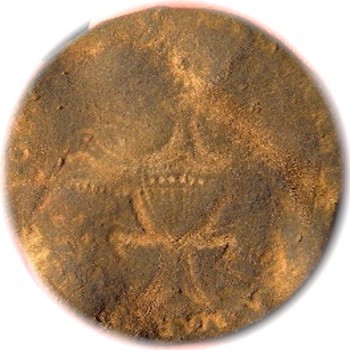

GWI 1-A MARCH THE FOURTH 1789 * MEMORABLE ERA
Color: A Sandy Orange.
Metal: Flat, 1-Piece, Impressed Design, Copper.
Size: 34mm.
Rarity: R-3
Variety Type: Pointed 9 Tail Variety.
Present Condition: An Excavated Example, Poor Planchet Condition, A Poor Impression Remains.
Obverse Button Analysis: This button has all the tell tale signs of being buried in the ground for countless years. The copper planchet is corroded from ground action, and shows numerous porous areas that throughout the surface. The Eagle’s body is still lightly outlined, but due to erosion it gives very little clarity to the body inner feathers. The head and neck is almost completely absent. The Liberty Shield still has a remnant image but damaged from ground action. The Olive Branch and petals has a very faint outline, but the rest of the image is absent. The Bundle of Three Arrows is unrecognizable. Only a light foot print remains of the Meridian Sun and it’s Rays. The 1789, Letter Date, and Catchphrase letters are decayed from ground action. Some letters are still recognizable, but most arent. This is a rough example, but should still be prized for a metal detector find.
Reverse Button Analysis: This is flat a one-piece button with a soldered on loop shank. The original shank is crushed flat. The surface shows corrosion and porosity.
Library Records Has Limited Information GWI 1-A-26:
History: Yes Recorded Sales Price: Digger Owner
Current Button Owner and Location:
Dug at Old Farm House.
The Robin Wolfe Collection.
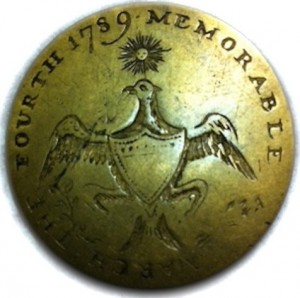

GWI 1-B MARCH THE FOURTH 1789 * MEMORABLE ERA
Color: A Naturally Toned Brass Olive Mix.
Metal: Flat, 1-Piece, Impressed Design, Brass.
Size: 34mm.
Rarity: R-3
Variety Type: The 9’s J-Knob Tail.
Present Condition: A Non Excavated Specimen, Strong Planchet Condition, A Good Impression Remains.
Obverse Button Analysis: This brass example has a nice golden olive mix which is very complimentary. The brass planchet is solid, and shows no signs of metal loss or deterioration from ground action. The button is smooth and flat to the touch, and only has a few light scratches on the surface. The Eagle has a nice deep strike for the outline, and gives a crystal clear image of the head, body, wings, and tail feathers. The inner details of the neck feathers is lost to a deep strike, and both legs and talons appears to be worn flat into the surface. The Liberty Shield still shows a good perimeter outline, but the dots are worn flat or bleeding into each other. The inner horizontal dots only have remnant images of their original strikes, and vertical stripes are completely worn into the surface. The Laurel Stem has a good image, and still shows the individual petals clearly. Unfortunately, the Bundle of Arrows only shows the tips, and nock feathers and shafts only have a faint image. The Meridian Sun has a strong bold strike, and shows all it’s individual Rays clearly. The 1789, and Letter Date still retains a strong strike impression, and is easy to read. The Catchphrase has a readable impression for MEMORABLE, but the word ERA is worn flat into the surface. Overall the button has a very attractive color with a lot of remaining designs still intact.
Reverse Button Analysis: This is flat a one-piece button with a soldered on loop shank. The shank is original, straight and intact. The surface is clean and smooth of any foreign obstructions.
Library Records Has Limited Information GWI 1-B-19:
History: Yes Recorded Sales Price: Yes
Current Button Owner and Location: ~ Oregon ~
The Markowitz Collection.
GWI 1-A MARCH THE FOURTH 1789 * MEMORABLE ERA
Color: A Dark Brown with Lighter Greenish-White Encrustations.
Metal: Flat, 1-Piece, Impressed Design, Brass.
Size: 34mm.
Rarity: R-3
Variety Type: The Pointed 9 Tail.
Present Condition: An Excavated Example, Strong Planchet Condition, A Strong Impression Remains.
Obverse Button Analysis: This button has strong strike impressions with a natural green encrustation making-up the patina. The brass planchet is solid and flat, and shows no signs of metal loss or deterioration to the planchet. The bottom left does have a slight waviness along the edge, but is barely noticeable. The button is smooth to the touch, and shows no scratches or abrasions to the surface. The Eagle has a nice deep strike impression, and has a clear outline for the head and body. The inner feather details of the body is really outstanding, and shows through the light dirt covering. The Liberty Shield has a clear outline, and shows of all the perimeter dots nicely. The inner horizontal dots and vertical stripes still retain a strong strike impression and show a good clear image. The Laurel Stem has a nice deep strike, and gives a crystal clear image of the stem, and all of it’s individual petals. Unfortunately, the Bundle of Arrows only retains a light foot print for the arrow tips, and nock feathers. The shafts themselves only have trace remnant impressions, and are mostly worn flat into the surface. The Meridian Sun has a strong deep strike, and shows all it’s individual Rays clearly. The 1789, and Letter Date still hold a good readable impression impression, but some of the letters are showing signs of decay. The Catchphrase is a bit weaker, only shows a half readable image for MEMORABLE. The Word ERA is unfortunately unrecognizable, but does retain some partial letters. Except for the minor letter decay, this excavated button has great impressions, color, and strong metal attributes. Overall this is another excellent dug example.
Reverse Button Analysis: This is flat a one-piece button with a soldered on loop shank. The shank is original, straight and intact. The surface has a slight bend on the edge, but is in good overall condition.
Library Records Has Limited Information GWI 1-A-27:
History: Yes Recorded Sales Price: Yes
Current Button Owner and Location: ~ Oklahoma ~
The C. Gray collection.
Previously from The Isabela Collection.~
2 of 2 Buttons Excavated in Windsor County, Vermont.

GWI 1-A MARCH THE FOURTH 1789 * MEMORABLE ERA
Color: A Golden Brass with Brown Undertones.
Metal: Flat, 1-Piece, Impressed Design, Brass.
Size: 34mm.
Rarity: R-3
Variety Type: The Pointed 9 Tail.
Present Condition: A Non Excavated Specimen, Excellent Planchet Condition, An Exceptional Impression Remains.
Obverse Button Analysis: This button has the age and charm that George Washington had portrayed himself. The brass planchet is solid and flat, and shows no signs of metal loss or deterioration from age or ground action. The button is smooth to the touch, and shows no scratches or abrasions affecting the design. There appears to be a few light porous spots, but only adds to the aged charm. The Eagle has a strong strike outline, and gives a clear image of the head and body. The head is depicted clearly, and the inner body feathers has a clear image. The Liberty Shield has a nice deep strike for the outline, and shows of all the perimeter dots separately. The shield’s inner horizontal dots and vertical stripes are depicted clearly without any flat wear. The Laurel Stem also retains a good deep strike, and gives a crystal clear image of the stem, and all of it’s individual petals. The Bundle of Arrows only has a moderate foot print, but still retains a clear image for the shafts, tips, and nock feathers. The Meridian Sun has a strong strike, and shows all it’s individual Rays clearly. The 1789, the Letter Date, and the Catchphrase still have a deep strike impression, with straight letter lines that are easy to read. Only the word ERA shows a lighter foot print. Overall, this is a wonderful button and a good representation for GWI 1-A.
Reverse Button Analysis: This is flat a one-piece button with a soldered on loop shank. The shank is original, straight and intact. The surface is in good overall condition.
Library Records Has Limited Information GWI 1-A-28:
History: Yes Recorded Sales Price: Yes
Current Button Owner and Location: ~ Virginia ~
George Washington’s Home at Mt Vernon, Virginia.~
Added to Mount Vernon Estate, Museum & Gardens.~
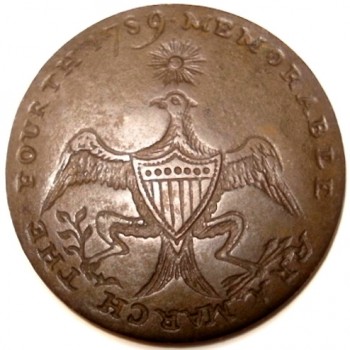
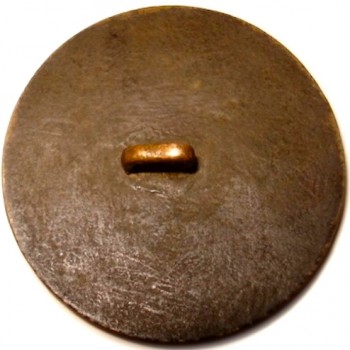
GWI 1-B MARCH THE FOURTH 1789 * MEMORABLE ERA
Color: A Milk Chocolate Patina
Metal: Flat, 1-Piece, Impressed Design, Brass.
Size: 34mm.
Rarity: R-3
Variety Type: The 9’s J-Knob Tail.
Present Condition: A Non Excavated Specimen, Excellent Planchet Condition, An Exceptional Impression Remains.
Obverse Button Analysis: This is an exceptional example of a George Washington Inaugural button. The button has been well preserved over the centuries, and the surface has an even milk chocolate color spread evenly throughout the obverse and reverse. The Copper planchet is solid and flat, and shows no metal fatigue or deterioration. The surface is smooth, and has no deep scratches or harsh abrasions that affect the design. The Eagle has a strong strike outline for the head and body. All the inner feather details of the wings and tail have a strong clear image. The Liberty Shield shows a nice bold strike outline, and most of the perimeter dots still show individual impressions. Only a few of the dots on the lower left hand side have a slight muting, but this is most likely the result from the original die strike. The shield’s inner detail of the horizontal dots and vertical stripes are superbly displayed with bold clarity. The Laurel Stem has a nice deep impression, and gives a clear image of all the petals. The Bundle of Arrows has a nice deep strike, and the arrow’s tips, shafts, and nock feathers still retain their original shape. The Meridian Sun and it’s all individual Rays, have a good strong strike impression, and show good clear individual lines. The 1789, the Letter Date, and Catchphrase show a strong impressions, and are easy to read. This button is in exceptional condition, and should be considered a prize in anyone’s GW Collection.
Reverse Button Analysis: This is flat a one-piece button with a soldered on loop shank. The Original Shank is intact, but bent over. The surface has a few light scratches, but minor and only noted for accuracy.
Library Records Has Limited Information GWI 1-B-20:
History: Yes Recorded Sales Price: Yes
Current Button Owner and Location: ~ Virginia ~
The Thomas Robinson Collection.~
Purchased at an Estate Sale, Luray


GWI 1-A MARCH THE FOURTH 1789 * MEMORABLE ERA
Color: A Dark Sea Green with Orange Porous Pockets.
Metal: Flat, 1-Piece, Impressed Design, Brass.
Size: 34mm.
Rarity: R-3
Variety Type: The Pointed 9 Tail.
Present Condition: An Excavated Example, Strong Planchet Condition, A Good Impression Remains.
Obverse Button Analysis: This button still retains a nice strong strike impression. The surface green encrustations and planchet discoloration indicate it must have been dug in an area with a lot of ground water. The brass planchet is still solid and flat, but shows signs of corrosion due to ground action. The button’s surface is a bit granular and coarse to the touch. There is micro-porous areas and encrustations on the obverse. Fortunately, the button shows no scratches or abrasions. The Eagle still retains a nice strike impression, and still has a clear outline of the head and body. Surprisingly, the inner feather details is still crystal clear without to much deterioration. The Liberty Shield has a strong outline, and shows of all the perimeter dots clearly. The shield’s inner horizontal dots and all the vertical stripes still retain a good clear image. The Olive Branch is unfortunately muddled underneath of encrustations to give a clear view for analysis. The Bundle of Arrows only shows a light foot print image for the arrow tips, and nock feathers. The shafts themselves only have remnant impressions, and are mostly worn flat into the surface. The Meridian Sun has a strong strike, and shows all it’s individual Rays clearly. The 1789, and Letter Date are either worn flat into the surface or decayed from ground action. The Catchphrase is also weak, and only gives a shallow image for MEMORABLE ERA. I like the patina’s natural color green from the earths soil. The image of the eagle is still spectacular. On the bad side, I don’t like the decay of the letters or date. Overall, it’s a nice button and makes a nice commemorative.
Reverse Button Analysis: This is flat a one-piece button with a soldered on loop shank. The shank is original, straight and intact.
Library Records Has Limited Information GWI 1-A-29:
History: Yes Recorded Sales Price: Digger Owner
Current Button Owner and Location: ~ Kentucky ~
The J. Speray Collection.~
Excavated by Jim S. in an old foundation in Lawenceburg, Kentucky

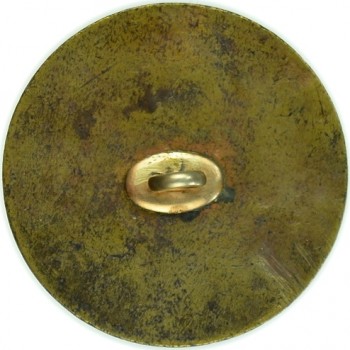
GWI 1-A MARCH THE FOURTH 1789 * MEMORABLE ERA
Color: A Yellow Brass with Patches of Grey Metal.
Metal: Flat, 1-Piece, Impressed Design, Gilt Brass.
Size: 34mm.
Rarity: R-3
Variety Type: The Pointed 9 Tail.
Present Condition: A Non Excavated Specimen, Strong Planchet Condition, A Strong Impression Remains.
Obverse Button Analysis: The brass planchet is solid and flat, but the surface is unfortunately marred with scratches and abrasions. The button appears coarse with small pockets of micro porosity. The Eagle has a nice strike impression, and clearly shows an outline of the head, body and feathers. The inner feather detail clear except for the legs. The Liberty Shield still retains a strong outline, and shows of all the individual perimeter dots clearly. The shield’s inner horizontal dots on the top portion of the shield are nicely stamped with a clear image. The vertical stripes in the lower portion of the shield is also strongly depicted. The Olive Branch only has a light foot print impression, and gives a hazy image of the stem and petals. The Bundle of Arrows has a nice deep strike and gives a wonderful image for the arrow tips, shafts, and nock feathers. The Meridian Sun has a moderate strike and lacks a clear image of all it’s individual Rays. The 1789, and Letter Date is still easily readable, but some of the letters and numbers are worn flat. The “F”R”1″7”. The Catchphrase has a nice strike and is easy to read. I like the patina’s color and remaining impressions, but unfortunately the scratches deter from the buttons beauty.
Reverse Button Analysis: This is flat a one-piece button with a soldered on loop shank. The shank is original, and intact, but a modern replacement shank.
Library Records Has Limited Information GWI 1-A-30:
History: Yes Recorded Sales Price: No
Current Button Owner and Location: No
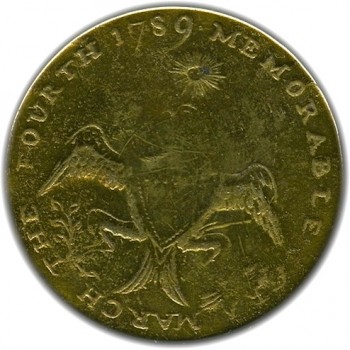
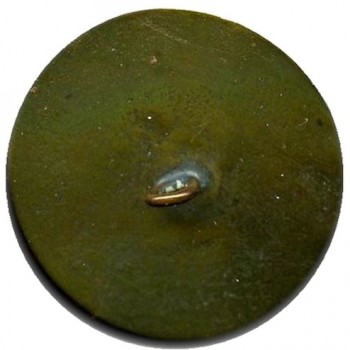
GWI 1-A MARCH THE FOURTH 1789 * MEMORABLE ERA
Color: A Golden Olive.
Metal: Flat, 1-Piece, Impressed Design, Gilt Brass.
Size: 34mm.
Rarity: R-3
Variety Type: The Pointed 9 Tail.
Present Condition: A Non Excavated Specimen, Strong Planchet Condition, A Good Impression Remains.
Obverse Button Analysis: This specimen has all the tell tale signs of being cleaned numerous times. The brass planchet is solid and flat, but the surface is marred with micro pitting. The button appears to be smooth in some areas and then marred in other spots. Unfortunately, the Eagle only retains partial image. The head, neck and talons are worn smooth into the planchet. The inner detail of the wings feathers is one of the buttons stronger points. The Liberty Shield’s lacks a strong outline and is missing half of the perimeter’s dots. The shield’s inner horizontal dots that is on the top portion of the shield is barely visible with only four remaining of the seven. The vertical stripes in the lower portion of the shield are worn flat into the surface. The Olive Branch is another strong point of this example. It gives a nice clear image of the stem and petals. The Bundle of Arrows shows is mostly worn away with only a faint residue of a single tip and nock feathers. The Meridian Sun is another strong point for the button. It retains a strong impression and clear image of all the rays. The 1789, Letter Date, and Catchphrase is still clearly readable, but some of the letters in “ERA” are getting worn down. With the eagle’s head image missing, this would only make a memento for a casual button collector.
Reverse Button Analysis: This is flat a one-piece button with a soldered on loop shank. The shank is original straight and intact, but a modern replacement.
Library Records Has Limited Information GWI 1-A-31:
History: No Recorded Sales Price: Yes
Current Button Owner and Location: No
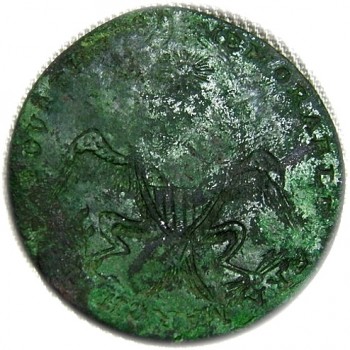
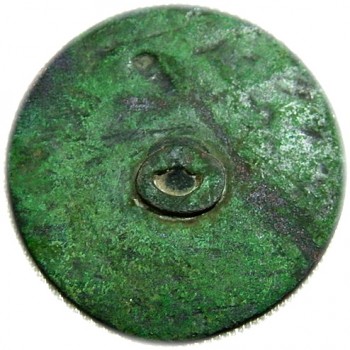
GWI 1-A MARCH THE FOURTH 1789 * MEMORABLE ERA
Color: A Lime Green.
Metal: Flat, 1-Piece, Impressed Design, Copper.
Size: 34mm.
Rarity: R-3
Variety Type: Pointed 9 Tail Variety.
Present Condition: An Excavated Example, Poor Planchet Condition, A Fair Impression Remains.
Obverse Button Analysis: This button has all the tell tale signs of being buried in the ground for countless years. The copper planchet is corroded from ground action, and shows numerous porous areas that throughout the surface. The Eagle’s body is still lightly outlined, but due to erosion it gives very little clarity to the body inner feathers. The head and neck is almost completely absent. The Liberty Shield has a partial image in the lower portion, but the top is completely worn into the surface. The Laurel Stem and two petals has a very faint outline, but the rest of the image is absent. The Bundle of Three Arrows still has a decent image. The shafts and tips being the strong point. Only a light foot print remains of the Meridian Sun and it’s Rays. The 1789, Letter Date, and Catchphrase letters are decayed from ground action. Some letters are still recognizable, but most arent. This is a rough example, but should still be prized for a metal detector find.
Reverse Button Analysis: This is flat a one-piece button with a soldered on loop shank. The original shank is crushed flat. The surface shows corrosion and porosity.
Library Records Has Limited Information GWI 1-A-32:
History: Yes Recorded Sales Price: Digger Owner
Current Button Owner and Location: ~ New York ~
Dug on a Farm in Geneso, New York 2011

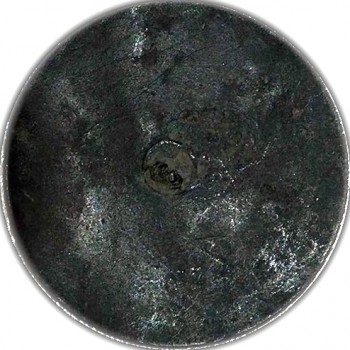
GWI 1-A MARCH THE FOURTH 1789 * MEMORABLE ERA
Color: A Silver Bare Metal.
Metal: Flat, 1-Piece, Impressed Design, Silver-Wash Copper?
Size: 34mm.
Rarity: R-3
Variety Type: Pointed 9 Tail Variety.
Present Condition: An Excavated Example, Good Planchet Condition, A Strong Impression Remains.
Obverse Button Analysis: This is a great dug specimen. Even though the planchet shows corrosion from ground action, the button’s impressions remained strong and clear. The copper planchet shows signs of metal fatigue and corrosion. The surface course or granular, and the planchet appears slightly wavy. There is the usual ground action signs of micro-posity, and metal corrosion. The surface has several light scratches, but time has blended them nicely into the metals finish. The Eagle shows a nice strong strike impression, and gives a good clear image of the head, body and feathers. The Liberty Shield shows a strong strike with a clear outline of most of the perimeter’s dots. The shield’s inner horizontal dots and vertical stripes are clearly visible with some slight encrustations covering over. The Laurel Stem only has a light foot print, but has a clear image of the stem, and most of the individual petals. The Bundle of Arrows has a good deep impression, and shows the shafts, tips, and nock feathers with clarity. The Meridian Sun has a strong strike, and all it’s individual Rays are clearly shown. The 1789 Date and the Letter Date has several letters worn down into the surface and the “8” is covered over with corrosion. The Catchphrase has several weak letters, but is present under close examination. Aside from the planchets condition due to ground action and the wording in the legend, the button has an extremely strong design impression. Kudo’s on the Bundle of Arrows!
Reverse Button Analysis: This is flat a one-piece button with a soldered on loop shank. The shank is broken off.
Library Records Has Limited Information GWI 1-A-33:
History: Yes Recorded Sales Price: Digger is Owner
Current Button Owner and Location: ~ Ontario Canada ~
The John Mc Allister Collection.~
Dug Around an Abandon House in Mount Vernon, Ohio around 1997.
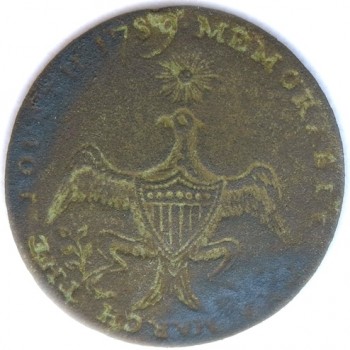
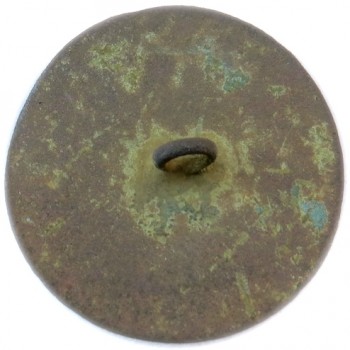
GWI 1-A MARCH THE FOURTH 1789 * MEMORABLE ERA
Color: A Luminescent Green.
Metal: Flat, 1-Piece, Stamped Design, Copper Planchet.
Size: 33.70mm.
Rarity: R-3
Variety Type: The Pointed 9 Tail.
Present Condition: An Excavated Specimen, Good Planchet Condition, Strong Impression Remains.
Obverse Button Analysis: This dug specimen was able to retain most of it’s original strike impressions, so with the illumine cent green color, it’s a keeper.lol. So the things I dislike first. The copper planchet is corroded and a bit wavy around the periphery. The surface is a bit granular to the touch. The digger unfortunately tried to bring out the pattern even more for greed and took an eraser to the legend and damaged/discolored the arrows, and the two words, “Fourth and “ERA”. So that being said, lets move on to why I bought it. The iridescent green color is awesome and nicely highlights all the impressed design areas. The Eagle has an exceptionally strong strike for the head, wings and body. All the inner feather detail remains strong. Another strong point is the Federal Shield’s dotted outline. It shows all the perimeter’s individual dots clearly without any muting or flatness. That is rare even among un-dug specimens. The shield’s inside horizontal dots and vertical lines are also crystal clear. The Laurel Stem also has a strong impression with a good clear image of the stem and it’s petals. As noted prior, the Bundle of Arrows is unfortunately damaged by the diggers attempt to clean it with an eraser. The arrow’s three feathers is mostly worn into the surface, but a faint residue shows a partial image. The Meridian Sun is another strong point of the button. It retains a strong strike and clear image of all the rays. The 1789, Letter Date, and Catchphrase is still easy to read, but unfortunately the diggers eraser damaged some of the letters in “Fourth” and “Era”. All being said, I found this to have stronger strike impressions then some un-dug specimens.
Reverse Button Analysis: This is flat a one-piece button with a soldered on loop shank. The shank is original straight and intact.
Library Records Has Limited Information WI 1-A-34:
History: Yes Recorded Sales Price: Yes
Current Button Owner and Location: ~ New York ~
The Isabela Collection.~
Excavated by Bruce in Rockland County New York October 2014
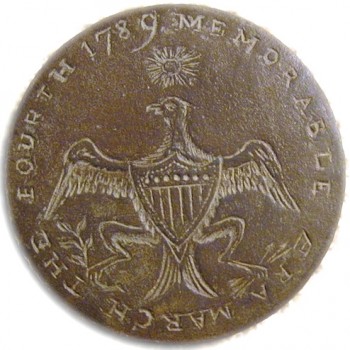
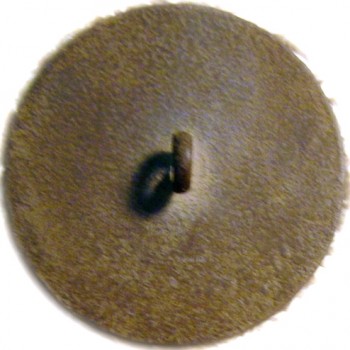
GWI 1-A MARCH THE FOURTH 1789 * MEMORABLE ERA
Color: A Silvery Brown.
Metal: Flat, 1-Piece, Stamped Design, Copper Planchet.
Size: 34mm.
Rarity: R-3
Variety Type: The Pointed 9 Tail.
Present Condition: An Excavated Specimen, Strong Planchet Casting, Strong / Exceptional Impressions Remain.
Obverse Button Analysis: .
Reverse Button Analysis: This is flat a one-piece button with a soldered on loop shank. The shank is original straight and intact.
Library Records Has Limited Information WI 1-A-35:
History: Yes Recorded Sales Price: Yes
Current Button Owner and Location: Yes
*DUG DEC 5, 2010 AT PLANTATION SITE ALONG CAPE FEAR RIVER 5 MILE BELOW WILIMTON N.C.
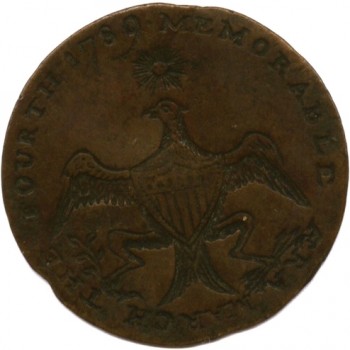
GWI 1-A MARCH THE FOURTH 1789 * MEMORABLE ERA
Color: A Silvery Brown.
Metal: Flat, 1-Piece, Stamped Design, Copper Planchet.
Size: 34mm.
Rarity: R-3
Variety Type: The Pointed 9 Tail.
Present Condition: An Excavated Specimen, Strong Planchet Casting, Strong / Exceptional Impressions Remain.
Obverse Button Analysis: .
Reverse Button Analysis: This is flat a one-piece button with a soldered on loop shank. The shank is original straight and intact.
Library Records Has Limited Information WI 1-A-36:
History: Yes Recorded Sales Price: Yes
Current Button Owner and Location: Yes

GWI 1-B MARCH THE FOURTH 1789 * MEMORABLE ERA
Color: A Silvery Brown.
Metal: Flat, 1-Piece, Stamped Design, Copper Planchet.
Size: 34mm.
Rarity: R-3
Variety Type: The 9’s J-Knob Tail.
Present Condition: An Excavated Specimen, Strong Planchet Casting, Strong / Exceptional Impressions Remain.
Obverse Button Analysis: .
Reverse Button Analysis: This is flat a one-piece button with a soldered on loop shank. The shank is original straight and intact.
Library Records Has Limited Information WI 1-B-20:
History: Yes Recorded Sales Price: Yes
Current Button Owner and Location: Yes
Kenneth Gilreath found 50yrs ago in Wheat Field Eastern TN
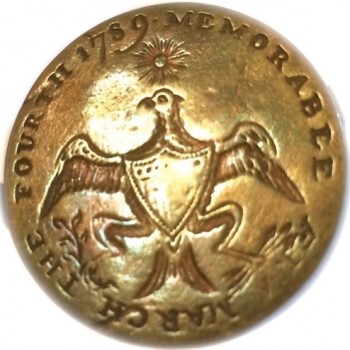
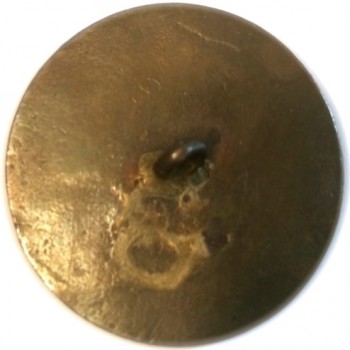
GWI 1-B MARCH THE FOURTH 1789 * MEMORABLE ERA
Color: A Silvery Brown.
Metal: Flat, 1-Piece, Stamped Design, Copper Planchet.
Size: 34mm.
Rarity: R-3
Variety Type: The 9’s J-Knob Tail.
Present Condition: An Excavated Specimen, Strong Planchet Casting, Strong / Exceptional Impressions Remain.
Obverse Button Analysis: .
Reverse Button Analysis: This is flat a one-piece button with a soldered on loop shank. The shank is original straight and intact.
Library Records Has Limited Information WI 1-B-21:
History: Yes Recorded Sales Price: Yes
Current Button Owner and Location: ~ Ohio ~
The Don Walsh Collection.
Don inherited 5 Buttons Grandmother Josephine Dewy who was the collector.
GWI 1-B MARCH THE FOURTH 1789 * MEMORABLE ERA “THE CONNECTICUT PATRIOT”
Color: A Light Sea White Green with Orange Porous Pockets.
Metal: Flat, 1-Piece, Impressed Design, Brass or Copper.
Size: 34.04mm.
Rarity: R-3
Variety Type: The 9’s J-Knob Tail.
Present Condition: An Excavated Example, Good Planchet Condition, A Strong Impression Remains.
Obverse Button Analysis: This button still retains a great strike impression. The surface green encrustations and planchet discoloration indicate it must have been dug in an area with a lot of glauconite in the soil. The planchet is wavy and shows signs of corrosion due to the years of ground action. The button’s surface is a bit granular and coarse in certain areas. Fortunately, the button shows no scratches or abrasions that affect the design. The Eagle still retains a nice strike impression, and still has a clear outline of the head and body. Surprisingly, the inner feather details is still crystal clear without to much deterioration. The Liberty Shield has a strong outline, and shows of all the perimeter stipples clearly. The shield’s inner horizontal stipples and all the vertical stripes still retain a good clear image. The Olive Branch is struck really nicely. The Bundle of Arrows has an above average image for the arrow tips, and nock feathers. The shafts themselves only have lighter impression. The Meridian Sun has a strong strike, and shows all it’s individual Rays clearly. The image of the eagle is still spectacular. The 1789, Letter Date, and Catchphrase is still clearly readable, but looses strength after the A in Memorable. This specimen has retained a Great Strike for being dug.
Reverse Button Analysis: This is flat a one-piece button with a soldered on loop shank. The shank is unfortunately missing.
Library Records Has Limited Information GWI 1-B.22:
History: Yes Recorded Sales Price: Yes
Current Button Owner and Location: ~ New York ~
Found in the yard of an 18th Century home by Kevin Kann in Shelton CT in 2012.
The Isabela Collection.~
GWI 1-B MARCH THE FOURTH 1789 * MEMORABLE ERA
Color: A Brass Yellow With White Letter Encrustations.
Metal: Flat, 1-Piece, Impressed Design, Brass.
Size: 34.mm.
Rarity: R-3
Variety Type: The 9’s J-Knob Tail.
Present Condition: A Non Excavated Specimen, Exceptional Planchet Condition, An Exceptional Impression Remains.
Obverse Button Analysis: This GWI 1-B button is one of the 5 best known specimens to exist. The surface color is a rich Golden Brass yellow with remnants of a White encrustation in 5 of the letters. The Eagle shows a nice strike impression, and has a clear outline of the head, neck, wings, and body feathers. The Liberty Shield has a strong outline, and shows of all the perimeter stipples clearly. The shield’s inner horizontal and vertical stripes still retain a good clear un-worn image. The Olive Branches a nice deep strike and shows all 7 petals nicely. The Bundle of 3 Arrows has an above average image for the arrow tips, and nock feathers. The shafts themselves only have lighter impression. That is the only flaw i see in the buttons impression. The Meridian Sun has a strong strike, and shows all it’s individual Rays clearly. The image of the eagle in my opinion is spectacular. The 1789, Letter Date, and Catchphrase is still clearly readable. This is a true Gem and should be a Crown Jewel in any button collection!
Reverse Button Analysis: This is flat a one-piece button with a soldered on loop shank. The shank is unfortunately missing.
Library Records Has Limited Information GWI 1-B.23:
History: Yes Recorded Sales Price: Yes
Current Button Owner and Location: ~ No ~
GWI 1-A MARCH THE FOURTH 1789 * MEMORABLE ERA
Color: A Coppery brown With Orange Undertones.
Metal: Flat, 1-Piece, Impressed Design, Brass.
Size: 34.00mm.
Rarity: R-3
Variety Type: The Pointed 9 Tail.
Present Condition: An Excavated Specimen, A Good Planchet Condition, A Good Impression Remains.
Obverse Button Analysis: This button still retains a great strike impression. The planchet is slightly wavy and shows pitting due to the years of ground action. The button’s surface has scratches or abrasions. The Eagle still retains a good strike impression with a clear outline of the head and body. The inner feather details are still semi-clear. The Liberty Shield has a strong outline, and shows most of the perimeter stipples clearly. The shield’s inner horizontal stipples and all the vertical stripes still retain a good clear image. The Olive Branch is struck nice, but only retains a footprint impression. The Bundle of Arrows is mostly worn away. The Meridian Sun is still visible. The 1789, Letter Date, and most of the Catchphrase is still readable. The word ERA is worn into the surface.
Reverse Button Analysis: This is flat a one-piece button with a soldered on loop shank. The shank is unfortunately missing.
Library Records Has Limited Information GWI 1-B.23:
History: No Last Recorded Sales Price: No
Current Button Owner and Location: ~ Texas ~
The Gary Embrey Collection.
GWI 1-C
American Lathe Turned Reverse
This GWI 1-C Specimen has a “Lathe Turn Back,” and should be classified as a new Sub-Variant for GWI 1. Even though there is several distinctions between GWI A, B, C. there is enough differences to justify it’s own Sub Variant letter-“C” under the commonality of GWI 1. There is no doubt the sub-variant was fabricated during Washington’s 1st Administration. The distinction between this variant and other George Washington inaugural sub-variants in all classes, is that this lathe turn reverse button is believed to be made by an Apprentice. Meaning, not made in England, and outside of normal guild contracts.
Wheels spinning, I believe the gentlemen of the Post Colonial Era engraving guild were congratulating each other and patting themselves on the back for being able to produce a “high quality engraving of a GWI button that was equal to the work of the Master Button Engravers in England. Well, this button was not made by those artisan engravers..lol. They made other GWI’s with Federal insignia. Probably, more parallel their entrance work with U.S. insignia followed by coins. — My Collector’s thoughts.
I have to conquer with Dale the button master and say this was done by a skilled apprentice of the Era. There are a few size and cut errors a Master Engraver would not allow in this final die product. Out of the 5 known surviving specimens, three are copper and two are brass. What I like about this George Washington Inaugural Button is that it was made here in America and not England. Since it was made in both brass and copper, one can reasonably assume it was produced and sold in some small quantity. For collectors of the era, one can appreciate the time honored style of a lathe turn reverse. This demonstrates that American Engraving Artist produced cut pieces equal to English manufacturing. Since I am an advent collector of GWI, I personally place a higher value on this time period inaugural button made by An American Apprentice over the commonly found English counterparts. Personally, I want the American heirloom that was produced in America, sold in America, and made by a Patriotic American Artist!
There are some differentiating characteristics in the design pattern which should be noted. First, there is no dot after 1798 date. Second, collector’s will note that some letters are cut differently, but 98% of the letters are the same. The “1” in the date depicts a shorten length. Also note, there is another sub variant without the “dot” after the date, but not a blunt “1”. The “S” pattern used instead of a completed “8” in the date is known in other mass produced dated varieties. This also gives evidence to period. This new Sub-Variant depicts a slightly different Sun Ray pattern. Dale noted if you put a different sun, the heraldic estoile over this pattern, you have the same sun as the known smiley face dated mass produced varieties, count these small rays on these examples and remove the six or eight pointed estoile and you have this sun pattern. (Confusing but accurate) This variant’s Eagle has slightly different wing and tail feathers. It is my Firm believe that this Sub-variant GWI 1-C was made right here in America!
GWI 1-C MARCH THE FOURTH 1789 * MEMORABLE ERA
Color: A Colorful Iridescent Gilt Brass Yellow with Flairs of Gold, Orange, Yellow, & Green.
Metal: Flat, 1-Piece, Stamped Design, Brass Planchet.
Size: 34mm.
Rarity: R-7
Variety Type: GWI 1-C / Lathe Turn Reverse / No Dot / Blunt “1” / Letter Sizes & Cuts / Meridian Sun / Leg Impressions.
Present Condition: A Non Dug Specimen, A Strong Planchet Condition, A Strong Clear Impressions Remains.
Obverse Button Analysis:
Reverse Button Analysis: This is flat a one-piece button with a soldered on loop shank. The shank is original straight and intact.
Library Records Has Limited Information GWI 1-C-1:
History: Yes Recorded Sales Price: Yes
Current Button Owner and Location: New Windsor, New York
The Robert J. Silverstein Collection.~
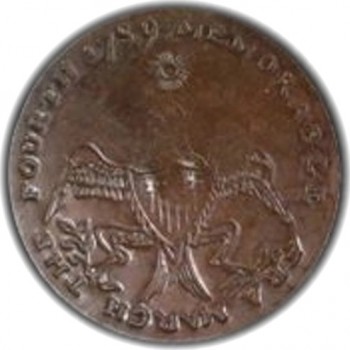
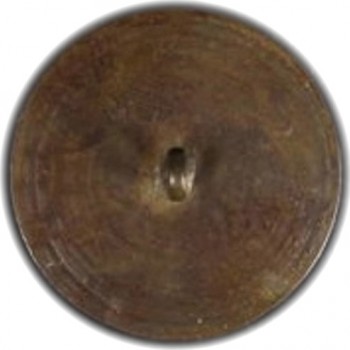
GWI 1-C MARCH THE FOURTH 1789 * MEMORABLE ERA
Color: A Shoe Polish Brown.
Metal: Flat, 1-Piece, Stamped Design, Copper Planchet.
Size: 34mm.
Rarity: R-7
Variety Type: The Lathe Turned.
Present Condition: A Non Excavated Specimen, Good Planchet Condition, A Strong Impressions Remains.
Obverse Button Analysis:
Reverse Button Analysis: This is flat a one-piece button with a soldered on loop shank. The shank is original straight and intact.
Library Records Has Limited Information GWI 1-C-2:
History: Yes Recorded Sales Price: Yes
Current Button Owner and Location: ~ X ~
The Dale Collection.~
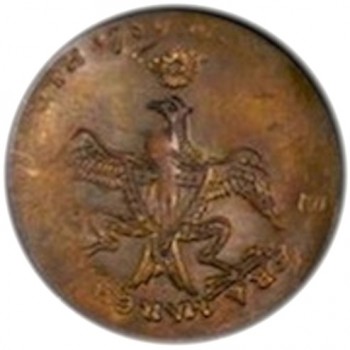
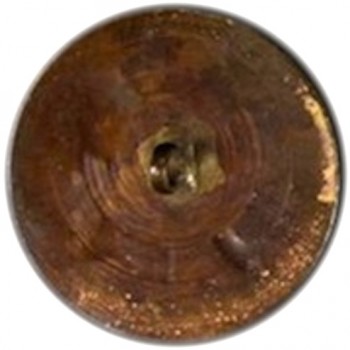
GWI 1-C MARCH THE FOURTH 1789 * MEMORABLE ERA
Color: Antique Brass with Brown Undertones
Metal: Flat, 1-Piece, Stamped Design, Brass Planchet.
Size: 34mm.
Rarity: R-6
Variety Type: The Lathe Turned.
Present Condition: A Non Excavated Specimen, Good Planchet Condition, A Strong Impressions Remains.
Obverse Button Analysis: I believe this is a new Sub-Variety for GWI 1. These appear tho be Manual lathe turned back buttons with a loop shank. This could possibly be the first pattern produced with only a few made originally. Prototype? I will list all three I know of. One has a copper planchet and the other two are brass. There are some differentiating characteristics in the design pattern to be noted. First, there is no dot after 1798 date. Second, there are a few letters that are cut differently, but 98% of the letters are the same. Blunt one in date other varieties have this no dot after date and blunt ones plus the S pattern number 8 in the date is known in other mass produced dated varieties. Different sun put the heraldic estoile over this pattern and you have the same sun as the known smiley face dated mass produced varieties,count these small rays on these examples and remove the six or eight pointed estoile and you have this sun pattern, different wing feathers,tail feathers and legs are a different die pattern,stippling is muted from the letters as the die is sunk deeply into the surface of the planchet. Era letters spaced like on mass produced button,same exact olive or laurel branch die pattern as the mass produced known’s,hooked 9 in date. Two brass and one copper specimen one R-7 two R-6’s total three buttons lathe turned backs.
Reverse Button Analysis: This is flat a one-piece button with a soldered on loop shank. The shank is original straight and intact, but replaced.
Library Records Has Limited Information GWI 1-C-3:
History: Yes Recorded Sales Price: Yes
Current Button Owner and Location: ~ X ~
The Dale Collection.~

